Quick filters:
Genghis khan Stock Photos and Images
 Genghis Khan founder of the Mongol Empire Stock Photohttps://www.alamy.com/image-license-details/?v=1https://www.alamy.com/genghis-khan-founder-of-the-mongol-empire-image61142790.html
Genghis Khan founder of the Mongol Empire Stock Photohttps://www.alamy.com/image-license-details/?v=1https://www.alamy.com/genghis-khan-founder-of-the-mongol-empire-image61142790.htmlRMDFD872–Genghis Khan founder of the Mongol Empire
 Genghis Khan (c.1162-1227), portrait of the founder of the Mongol Empire, paint and ink on silk, 14th century Stock Photohttps://www.alamy.com/image-license-details/?v=1https://www.alamy.com/stock-photo-genghis-khan-c1162-1227-portrait-of-the-founder-of-the-mongol-empire-172308011.html
Genghis Khan (c.1162-1227), portrait of the founder of the Mongol Empire, paint and ink on silk, 14th century Stock Photohttps://www.alamy.com/image-license-details/?v=1https://www.alamy.com/stock-photo-genghis-khan-c1162-1227-portrait-of-the-founder-of-the-mongol-empire-172308011.htmlRMM098HF–Genghis Khan (c.1162-1227), portrait of the founder of the Mongol Empire, paint and ink on silk, 14th century
 Genghis Khan, Supreme Emperor of the Mongols Stock Photohttps://www.alamy.com/image-license-details/?v=1https://www.alamy.com/stock-photo-genghis-khan-supreme-emperor-of-the-mongols-135093366.html
Genghis Khan, Supreme Emperor of the Mongols Stock Photohttps://www.alamy.com/image-license-details/?v=1https://www.alamy.com/stock-photo-genghis-khan-supreme-emperor-of-the-mongols-135093366.htmlRMHRP0Y2–Genghis Khan, Supreme Emperor of the Mongols
 Mongolia: 19th century French representation of Genghis Khan (r.1206-1227), 1st Khagan of the Mongol Empire. Genghis Khan (1162–1227), born Borjigin Temujin, was the founder, Khan (ruler) and Khagan (emperor) of the Mongol Empire, which became the largest contiguous empire in history after his death. He came to power by uniting many of the nomadic tribes of northeast Asia. After founding the Mongol Empire and being proclaimed 'Genghis Khan', he began the Mongol invasions that would ultimately result in the conquest of most of Eurasia. Stock Photohttps://www.alamy.com/image-license-details/?v=1https://www.alamy.com/mongolia-19th-century-french-representation-of-genghis-khan-r1206-1227-1st-khagan-of-the-mongol-empire-genghis-khan-11621227-born-borjigin-temujin-was-the-founder-khan-ruler-and-khagan-emperor-of-the-mongol-empire-which-became-the-largest-contiguous-empire-in-history-after-his-death-he-came-to-power-by-uniting-many-of-the-nomadic-tribes-of-northeast-asia-after-founding-the-mongol-empire-and-being-proclaimed-genghis-khan-he-began-the-mongol-invasions-that-would-ultimately-result-in-the-conquest-of-most-of-eurasia-image344230574.html
Mongolia: 19th century French representation of Genghis Khan (r.1206-1227), 1st Khagan of the Mongol Empire. Genghis Khan (1162–1227), born Borjigin Temujin, was the founder, Khan (ruler) and Khagan (emperor) of the Mongol Empire, which became the largest contiguous empire in history after his death. He came to power by uniting many of the nomadic tribes of northeast Asia. After founding the Mongol Empire and being proclaimed 'Genghis Khan', he began the Mongol invasions that would ultimately result in the conquest of most of Eurasia. Stock Photohttps://www.alamy.com/image-license-details/?v=1https://www.alamy.com/mongolia-19th-century-french-representation-of-genghis-khan-r1206-1227-1st-khagan-of-the-mongol-empire-genghis-khan-11621227-born-borjigin-temujin-was-the-founder-khan-ruler-and-khagan-emperor-of-the-mongol-empire-which-became-the-largest-contiguous-empire-in-history-after-his-death-he-came-to-power-by-uniting-many-of-the-nomadic-tribes-of-northeast-asia-after-founding-the-mongol-empire-and-being-proclaimed-genghis-khan-he-began-the-mongol-invasions-that-would-ultimately-result-in-the-conquest-of-most-of-eurasia-image344230574.htmlRM2B011H2–Mongolia: 19th century French representation of Genghis Khan (r.1206-1227), 1st Khagan of the Mongol Empire. Genghis Khan (1162–1227), born Borjigin Temujin, was the founder, Khan (ruler) and Khagan (emperor) of the Mongol Empire, which became the largest contiguous empire in history after his death. He came to power by uniting many of the nomadic tribes of northeast Asia. After founding the Mongol Empire and being proclaimed 'Genghis Khan', he began the Mongol invasions that would ultimately result in the conquest of most of Eurasia.
 Genghis Khan, born Temüjin, was the founder and Great Khan of the Mongol Empire Stock Photohttps://www.alamy.com/image-license-details/?v=1https://www.alamy.com/stock-photo-genghis-khan-born-temjin-was-the-founder-and-great-khan-of-the-mongol-90821078.html
Genghis Khan, born Temüjin, was the founder and Great Khan of the Mongol Empire Stock Photohttps://www.alamy.com/image-license-details/?v=1https://www.alamy.com/stock-photo-genghis-khan-born-temjin-was-the-founder-and-great-khan-of-the-mongol-90821078.htmlRMF7N75X–Genghis Khan, born Temüjin, was the founder and Great Khan of the Mongol Empire
 GENGHIS KHAN - Mongul warrior and ruler (c 1162-1227) Stock Photohttps://www.alamy.com/image-license-details/?v=1https://www.alamy.com/stock-photo-genghis-khan-mongul-warrior-and-ruler-c-1162-1227-27481176.html
GENGHIS KHAN - Mongul warrior and ruler (c 1162-1227) Stock Photohttps://www.alamy.com/image-license-details/?v=1https://www.alamy.com/stock-photo-genghis-khan-mongul-warrior-and-ruler-c-1162-1227-27481176.htmlRMBGKTEG–GENGHIS KHAN - Mongul warrior and ruler (c 1162-1227)
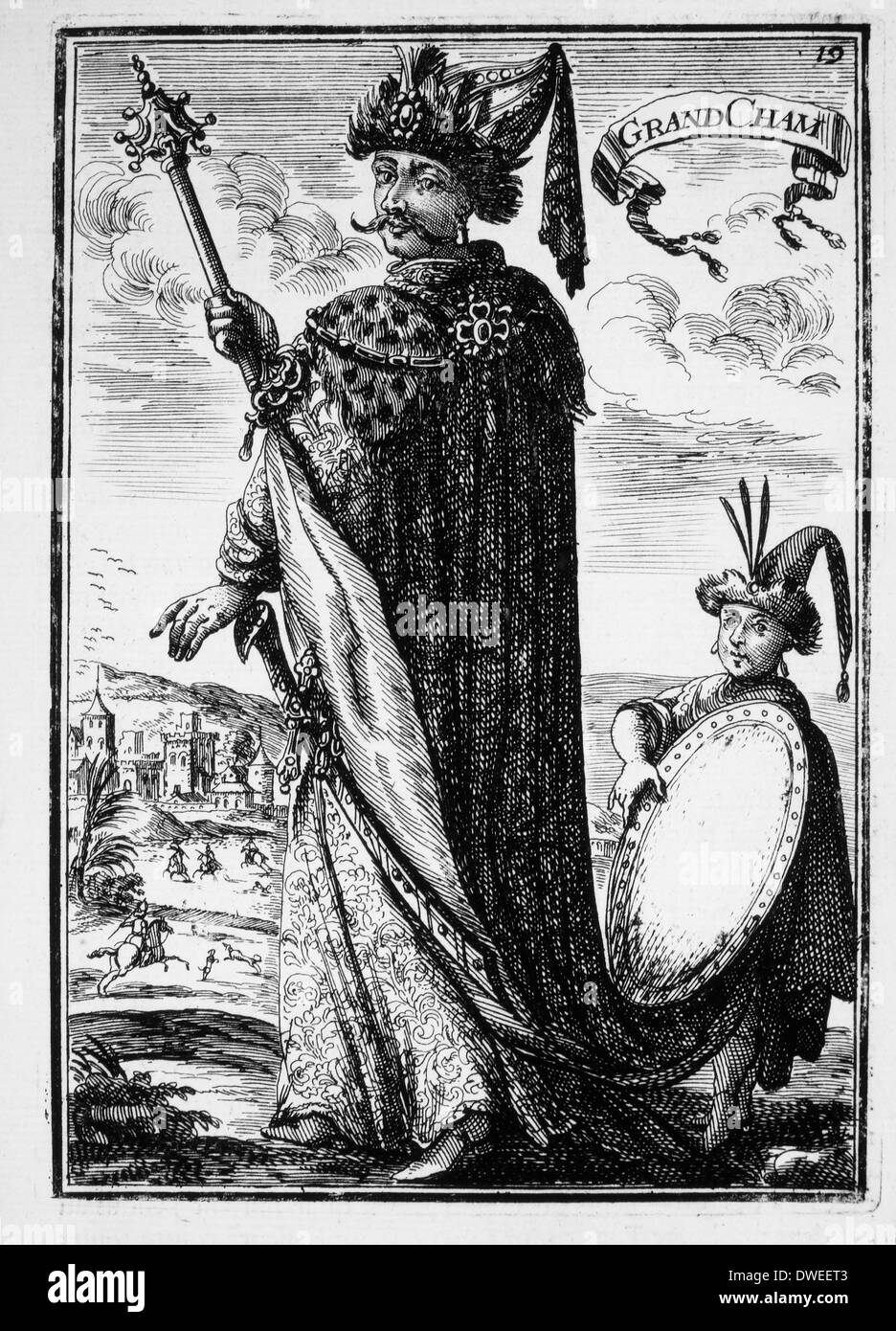 Genghis Khan (1162-1227), Mongol Ruler Originally Named Temujin, 1683 Woodcut Stock Photohttps://www.alamy.com/image-license-details/?v=1https://www.alamy.com/genghis-khan-1162-1227-mongol-ruler-originally-named-temujin-1683-image67316483.html
Genghis Khan (1162-1227), Mongol Ruler Originally Named Temujin, 1683 Woodcut Stock Photohttps://www.alamy.com/image-license-details/?v=1https://www.alamy.com/genghis-khan-1162-1227-mongol-ruler-originally-named-temujin-1683-image67316483.htmlRMDWEET3–Genghis Khan (1162-1227), Mongol Ruler Originally Named Temujin, 1683 Woodcut
 Genghis Khan Statue Ulaanbaatar Mongolia Stock Photohttps://www.alamy.com/image-license-details/?v=1https://www.alamy.com/stock-photo-genghis-khan-statue-ulaanbaatar-mongolia-41979667.html
Genghis Khan Statue Ulaanbaatar Mongolia Stock Photohttps://www.alamy.com/image-license-details/?v=1https://www.alamy.com/stock-photo-genghis-khan-statue-ulaanbaatar-mongolia-41979667.htmlRMCC89DR–Genghis Khan Statue Ulaanbaatar Mongolia
 Genghis Khan Attacks Stock Photohttps://www.alamy.com/image-license-details/?v=1https://www.alamy.com/genghis-khan-attacks-image5544618.html
Genghis Khan Attacks Stock Photohttps://www.alamy.com/image-license-details/?v=1https://www.alamy.com/genghis-khan-attacks-image5544618.htmlRMAY3PAB–Genghis Khan Attacks
 Genghis Khan, Mongol warrior and conqueror, (1780). Artist: Pierre Duflos Stock Photohttps://www.alamy.com/image-license-details/?v=1https://www.alamy.com/genghis-khan-mongol-warrior-and-conqueror-1780-artist-pierre-duflos-image60148271.html
Genghis Khan, Mongol warrior and conqueror, (1780). Artist: Pierre Duflos Stock Photohttps://www.alamy.com/image-license-details/?v=1https://www.alamy.com/genghis-khan-mongol-warrior-and-conqueror-1780-artist-pierre-duflos-image60148271.htmlRMDDRYMF–Genghis Khan, Mongol warrior and conqueror, (1780). Artist: Pierre Duflos
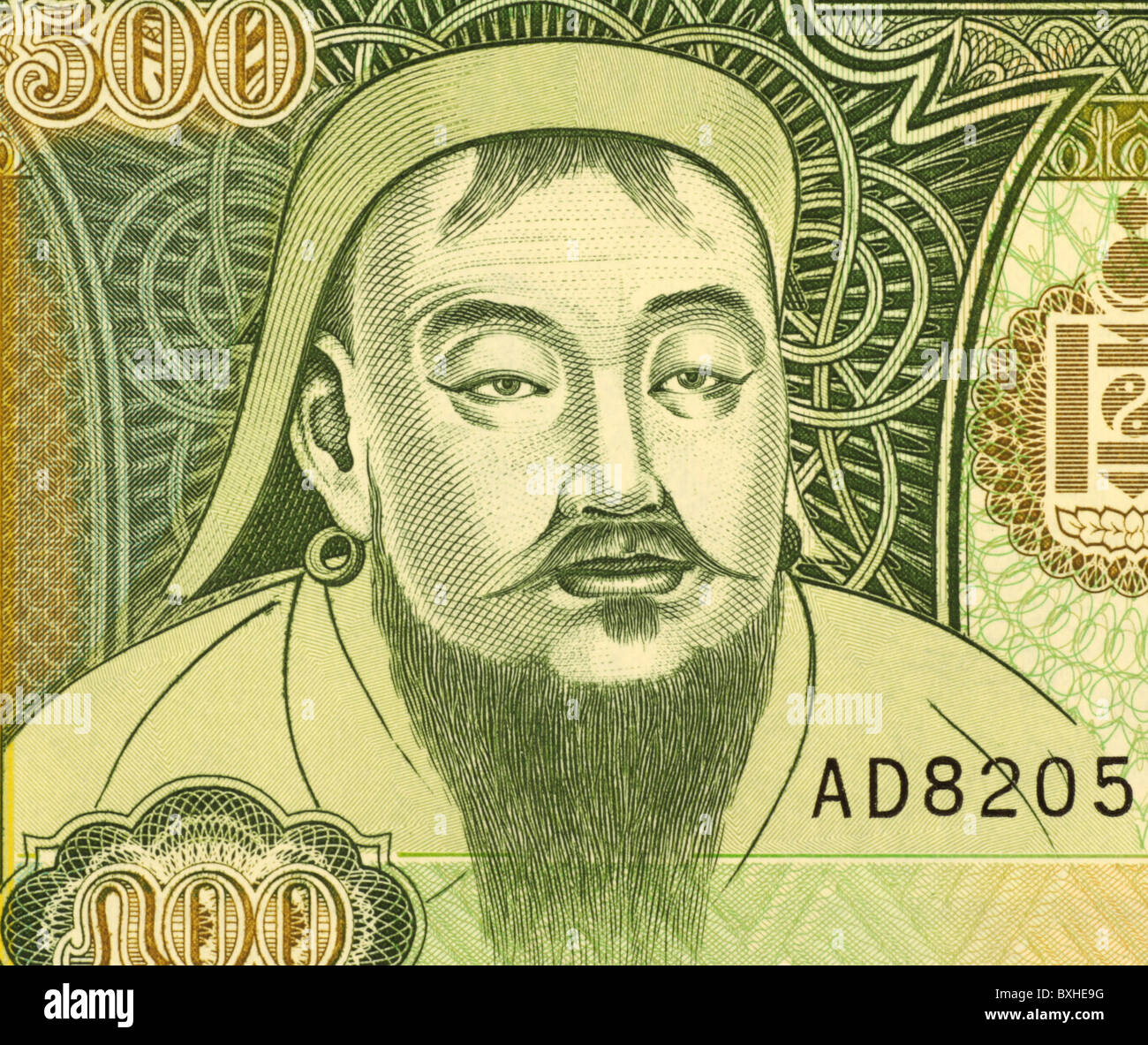 Genghis Khan (1162-1227) on 500 Tugrik 1997 Banknote from Mongolia. Founder, ruler & emperor of the Mongol Empire. Stock Photohttps://www.alamy.com/image-license-details/?v=1https://www.alamy.com/stock-photo-genghis-khan-1162-1227-on-500-tugrik-1997-banknote-from-mongolia-founder-33575852.html
Genghis Khan (1162-1227) on 500 Tugrik 1997 Banknote from Mongolia. Founder, ruler & emperor of the Mongol Empire. Stock Photohttps://www.alamy.com/image-license-details/?v=1https://www.alamy.com/stock-photo-genghis-khan-1162-1227-on-500-tugrik-1997-banknote-from-mongolia-founder-33575852.htmlRFBXHE9G–Genghis Khan (1162-1227) on 500 Tugrik 1997 Banknote from Mongolia. Founder, ruler & emperor of the Mongol Empire.
 Mongolia, Khentii province, Genghis khan statue at Khokh Nuur, the bleu lake Stock Photohttps://www.alamy.com/image-license-details/?v=1https://www.alamy.com/stock-photo-mongolia-khentii-province-genghis-khan-statue-at-khokh-nuur-the-bleu-126625413.html
Mongolia, Khentii province, Genghis khan statue at Khokh Nuur, the bleu lake Stock Photohttps://www.alamy.com/image-license-details/?v=1https://www.alamy.com/stock-photo-mongolia-khentii-province-genghis-khan-statue-at-khokh-nuur-the-bleu-126625413.htmlRMHA0805–Mongolia, Khentii province, Genghis khan statue at Khokh Nuur, the bleu lake
 Genghis Khan monument in Sukhbaatar Square, Ulaanbaatar, Mongolia Stock Photohttps://www.alamy.com/image-license-details/?v=1https://www.alamy.com/stock-photo-genghis-khan-monument-in-sukhbaatar-square-ulaanbaatar-mongolia-25114229.html
Genghis Khan monument in Sukhbaatar Square, Ulaanbaatar, Mongolia Stock Photohttps://www.alamy.com/image-license-details/?v=1https://www.alamy.com/stock-photo-genghis-khan-monument-in-sukhbaatar-square-ulaanbaatar-mongolia-25114229.htmlRMBCT1CN–Genghis Khan monument in Sukhbaatar Square, Ulaanbaatar, Mongolia
 Genghis Khan enthroned with his sons, Ogedei and Jochi Ms suppl Persian 1113 f44v by Rachid al-Din Fazl -ollah Hamadani Stock Photohttps://www.alamy.com/image-license-details/?v=1https://www.alamy.com/stock-photo-genghis-khan-enthroned-with-his-sons-ogedei-and-jochi-ms-suppl-persian-28113549.html
Genghis Khan enthroned with his sons, Ogedei and Jochi Ms suppl Persian 1113 f44v by Rachid al-Din Fazl -ollah Hamadani Stock Photohttps://www.alamy.com/image-license-details/?v=1https://www.alamy.com/stock-photo-genghis-khan-enthroned-with-his-sons-ogedei-and-jochi-ms-suppl-persian-28113549.htmlRMBHMK39–Genghis Khan enthroned with his sons, Ogedei and Jochi Ms suppl Persian 1113 f44v by Rachid al-Din Fazl -ollah Hamadani
 Taizu, better known as Genghis Khan, 14th century Stock Photohttps://www.alamy.com/image-license-details/?v=1https://www.alamy.com/stock-photo-taizu-better-known-as-genghis-khan-14th-century-147832038.html
Taizu, better known as Genghis Khan, 14th century Stock Photohttps://www.alamy.com/image-license-details/?v=1https://www.alamy.com/stock-photo-taizu-better-known-as-genghis-khan-14th-century-147832038.htmlRMJGE97J–Taizu, better known as Genghis Khan, 14th century
 Siege of Baghdad, folio from an illuminated manuscript of the History of Genghis Khan, Khem Karan, Indian, active c.1580–c.1605, Indian, Mughal period, 1526–1858, reign of Akbar, Mughal, reigned 1556–1605, 1596, Ink, opaque watercolor, and gold on paper, Made in Lahore, Punjab province, Southern Asia, Pakistan, Asia, Drawings & watercolors, paintings, image: 13 3/4 x 8 7/8 in. (34.9 x 22.5 cm Stock Photohttps://www.alamy.com/image-license-details/?v=1https://www.alamy.com/siege-of-baghdad-folio-from-an-illuminated-manuscript-of-the-history-of-genghis-khan-khem-karan-indian-active-c1580c1605-indian-mughal-period-15261858-reign-of-akbar-mughal-reigned-15561605-1596-ink-opaque-watercolor-and-gold-on-paper-made-in-lahore-punjab-province-southern-asia-pakistan-asia-drawings-watercolors-paintings-image-13-34-x-8-78-in-349-x-225-cm-image454293020.html
Siege of Baghdad, folio from an illuminated manuscript of the History of Genghis Khan, Khem Karan, Indian, active c.1580–c.1605, Indian, Mughal period, 1526–1858, reign of Akbar, Mughal, reigned 1556–1605, 1596, Ink, opaque watercolor, and gold on paper, Made in Lahore, Punjab province, Southern Asia, Pakistan, Asia, Drawings & watercolors, paintings, image: 13 3/4 x 8 7/8 in. (34.9 x 22.5 cm Stock Photohttps://www.alamy.com/image-license-details/?v=1https://www.alamy.com/siege-of-baghdad-folio-from-an-illuminated-manuscript-of-the-history-of-genghis-khan-khem-karan-indian-active-c1580c1605-indian-mughal-period-15261858-reign-of-akbar-mughal-reigned-15561605-1596-ink-opaque-watercolor-and-gold-on-paper-made-in-lahore-punjab-province-southern-asia-pakistan-asia-drawings-watercolors-paintings-image-13-34-x-8-78-in-349-x-225-cm-image454293020.htmlRM2HB2RAM–Siege of Baghdad, folio from an illuminated manuscript of the History of Genghis Khan, Khem Karan, Indian, active c.1580–c.1605, Indian, Mughal period, 1526–1858, reign of Akbar, Mughal, reigned 1556–1605, 1596, Ink, opaque watercolor, and gold on paper, Made in Lahore, Punjab province, Southern Asia, Pakistan, Asia, Drawings & watercolors, paintings, image: 13 3/4 x 8 7/8 in. (34.9 x 22.5 cm
 Genghis Khan statue by Dashi Namdakov, at Marble Arch, central London UK Stock Photohttps://www.alamy.com/image-license-details/?v=1https://www.alamy.com/stock-photo-genghis-khan-statue-by-dashi-namdakov-at-marble-arch-central-london-56431705.html
Genghis Khan statue by Dashi Namdakov, at Marble Arch, central London UK Stock Photohttps://www.alamy.com/image-license-details/?v=1https://www.alamy.com/stock-photo-genghis-khan-statue-by-dashi-namdakov-at-marble-arch-central-london-56431705.htmlRMD7PK61–Genghis Khan statue by Dashi Namdakov, at Marble Arch, central London UK
 Mongolia, Ulaan Baatar, Genghis Khan statue Stock Photohttps://www.alamy.com/image-license-details/?v=1https://www.alamy.com/stock-photo-mongolia-ulaan-baatar-genghis-khan-statue-39259666.html
Mongolia, Ulaan Baatar, Genghis Khan statue Stock Photohttps://www.alamy.com/image-license-details/?v=1https://www.alamy.com/stock-photo-mongolia-ulaan-baatar-genghis-khan-statue-39259666.htmlRMC7TC2X–Mongolia, Ulaan Baatar, Genghis Khan statue
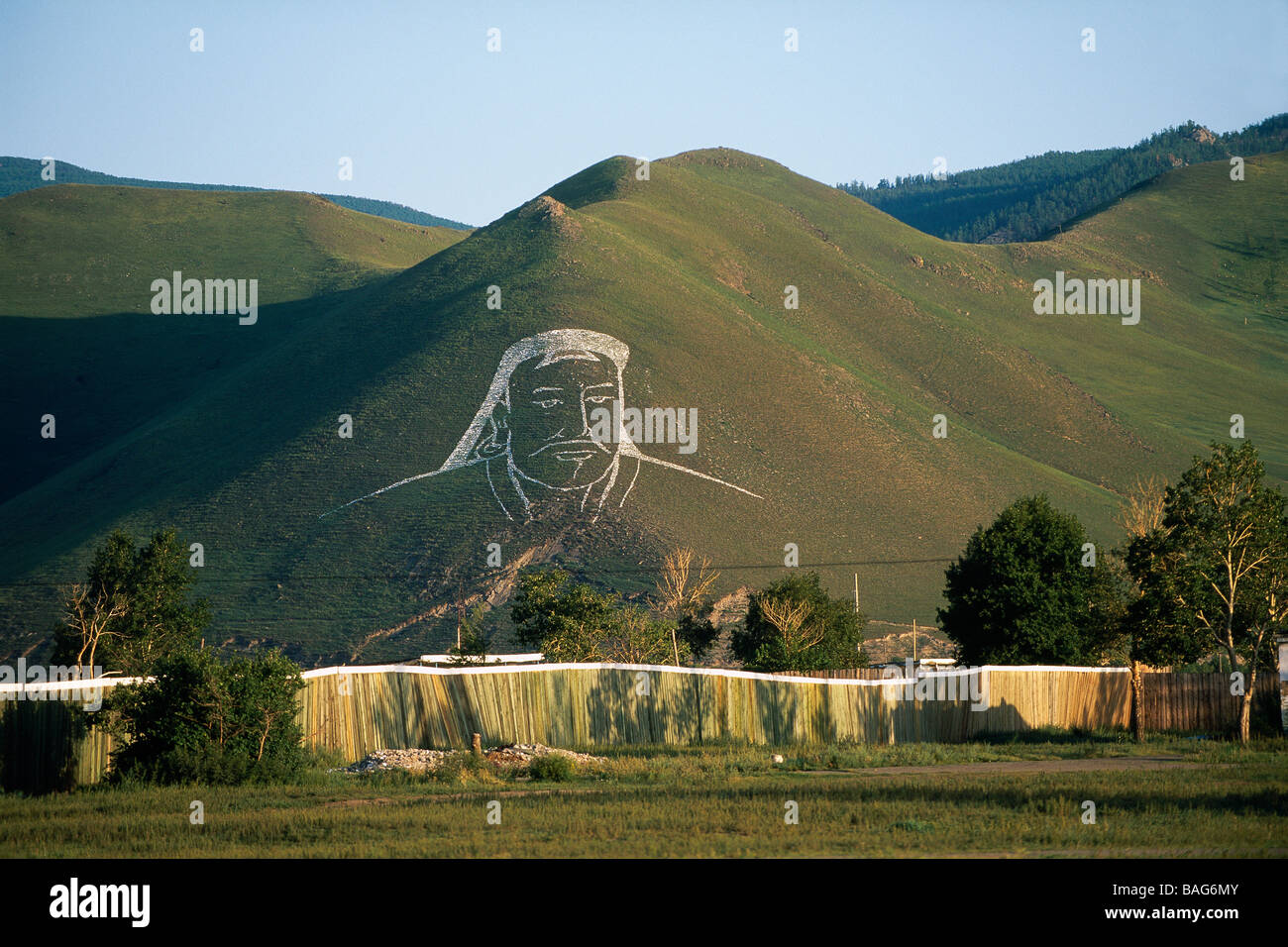 Mongolia, Ulanbaatar, huge portrait of Genghis Khan on a hill Stock Photohttps://www.alamy.com/image-license-details/?v=1https://www.alamy.com/stock-photo-mongolia-ulanbaatar-huge-portrait-of-genghis-khan-on-a-hill-23713451.html
Mongolia, Ulanbaatar, huge portrait of Genghis Khan on a hill Stock Photohttps://www.alamy.com/image-license-details/?v=1https://www.alamy.com/stock-photo-mongolia-ulanbaatar-huge-portrait-of-genghis-khan-on-a-hill-23713451.htmlRMBAG6MY–Mongolia, Ulanbaatar, huge portrait of Genghis Khan on a hill
 Genghis Khan Stock Photohttps://www.alamy.com/image-license-details/?v=1https://www.alamy.com/genghis-khan-image184233646.html
Genghis Khan Stock Photohttps://www.alamy.com/image-license-details/?v=1https://www.alamy.com/genghis-khan-image184233646.htmlRMMKMFW2–Genghis Khan
 Genghis Khan (c.1162-1227). Illustration, dating from around 1430, showing Genghis Khan ascending to the throne in 1206. Stock Photohttps://www.alamy.com/image-license-details/?v=1https://www.alamy.com/stock-photo-genghis-khan-c1162-1227-illustration-dating-from-around-1430-showing-172308010.html
Genghis Khan (c.1162-1227). Illustration, dating from around 1430, showing Genghis Khan ascending to the throne in 1206. Stock Photohttps://www.alamy.com/image-license-details/?v=1https://www.alamy.com/stock-photo-genghis-khan-c1162-1227-illustration-dating-from-around-1430-showing-172308010.htmlRMM098HE–Genghis Khan (c.1162-1227). Illustration, dating from around 1430, showing Genghis Khan ascending to the throne in 1206.
 Genghis Khan, Mongol ruler, founder of the Mongol Empire. Stock Photohttps://www.alamy.com/image-license-details/?v=1https://www.alamy.com/genghis-khan-mongol-ruler-founder-of-the-mongol-empire-image247137828.html
Genghis Khan, Mongol ruler, founder of the Mongol Empire. Stock Photohttps://www.alamy.com/image-license-details/?v=1https://www.alamy.com/genghis-khan-mongol-ruler-founder-of-the-mongol-empire-image247137828.htmlRMTA22R0–Genghis Khan, Mongol ruler, founder of the Mongol Empire.
 Mongolia/China: Composite image of eight Mongol Khagans who ruled between 1206 and 1332. Ink on silk album portraits, 14th century. Composite image of eight Mongol Khagans who ruled between 1206 and 1332. Top left to bottom right: Genghis Khan (1206-1227); Ogedei Khan (1229-1241); Kublai Khan (1260-1294); Temur Khan (1294-1307); Buyantu Khan (1311-1320); Kulug Khan (1307-1311); Jayaatu Khan (1328-1329; 1329-1332); Rinchinbal Khan (1332). Stock Photohttps://www.alamy.com/image-license-details/?v=1https://www.alamy.com/mongoliachina-composite-image-of-eight-mongol-khagans-who-ruled-between-1206-and-1332-ink-on-silk-album-portraits-14th-century-composite-image-of-eight-mongol-khagans-who-ruled-between-1206-and-1332-top-left-to-bottom-right-genghis-khan-1206-1227-ogedei-khan-1229-1241-kublai-khan-1260-1294-temur-khan-1294-1307-buyantu-khan-1311-1320-kulug-khan-1307-1311-jayaatu-khan-1328-1329-1329-1332-rinchinbal-khan-1332-image344230621.html
Mongolia/China: Composite image of eight Mongol Khagans who ruled between 1206 and 1332. Ink on silk album portraits, 14th century. Composite image of eight Mongol Khagans who ruled between 1206 and 1332. Top left to bottom right: Genghis Khan (1206-1227); Ogedei Khan (1229-1241); Kublai Khan (1260-1294); Temur Khan (1294-1307); Buyantu Khan (1311-1320); Kulug Khan (1307-1311); Jayaatu Khan (1328-1329; 1329-1332); Rinchinbal Khan (1332). Stock Photohttps://www.alamy.com/image-license-details/?v=1https://www.alamy.com/mongoliachina-composite-image-of-eight-mongol-khagans-who-ruled-between-1206-and-1332-ink-on-silk-album-portraits-14th-century-composite-image-of-eight-mongol-khagans-who-ruled-between-1206-and-1332-top-left-to-bottom-right-genghis-khan-1206-1227-ogedei-khan-1229-1241-kublai-khan-1260-1294-temur-khan-1294-1307-buyantu-khan-1311-1320-kulug-khan-1307-1311-jayaatu-khan-1328-1329-1329-1332-rinchinbal-khan-1332-image344230621.htmlRM2B011JN–Mongolia/China: Composite image of eight Mongol Khagans who ruled between 1206 and 1332. Ink on silk album portraits, 14th century. Composite image of eight Mongol Khagans who ruled between 1206 and 1332. Top left to bottom right: Genghis Khan (1206-1227); Ogedei Khan (1229-1241); Kublai Khan (1260-1294); Temur Khan (1294-1307); Buyantu Khan (1311-1320); Kulug Khan (1307-1311); Jayaatu Khan (1328-1329; 1329-1332); Rinchinbal Khan (1332).
 Russian theatre costume design depicting Genghis Khan 1155 - 1227, born Temüjin founder, Khan (ruler) and Khagan (emperor) of the Mongol Empire, which became the largest contiguous empire in history after his death. Stock Photohttps://www.alamy.com/image-license-details/?v=1https://www.alamy.com/stock-photo-russian-theatre-costume-design-depicting-genghis-khan-1155-1227-born-57353349.html
Russian theatre costume design depicting Genghis Khan 1155 - 1227, born Temüjin founder, Khan (ruler) and Khagan (emperor) of the Mongol Empire, which became the largest contiguous empire in history after his death. Stock Photohttps://www.alamy.com/image-license-details/?v=1https://www.alamy.com/stock-photo-russian-theatre-costume-design-depicting-genghis-khan-1155-1227-born-57353349.htmlRMD98JNW–Russian theatre costume design depicting Genghis Khan 1155 - 1227, born Temüjin founder, Khan (ruler) and Khagan (emperor) of the Mongol Empire, which became the largest contiguous empire in history after his death.
 GENGHIS KHAN -1964 Stock Photohttps://www.alamy.com/image-license-details/?v=1https://www.alamy.com/stock-photo-genghis-khan-1964-29249376.html
GENGHIS KHAN -1964 Stock Photohttps://www.alamy.com/image-license-details/?v=1https://www.alamy.com/stock-photo-genghis-khan-1964-29249376.htmlRMBKGBTG–GENGHIS KHAN -1964
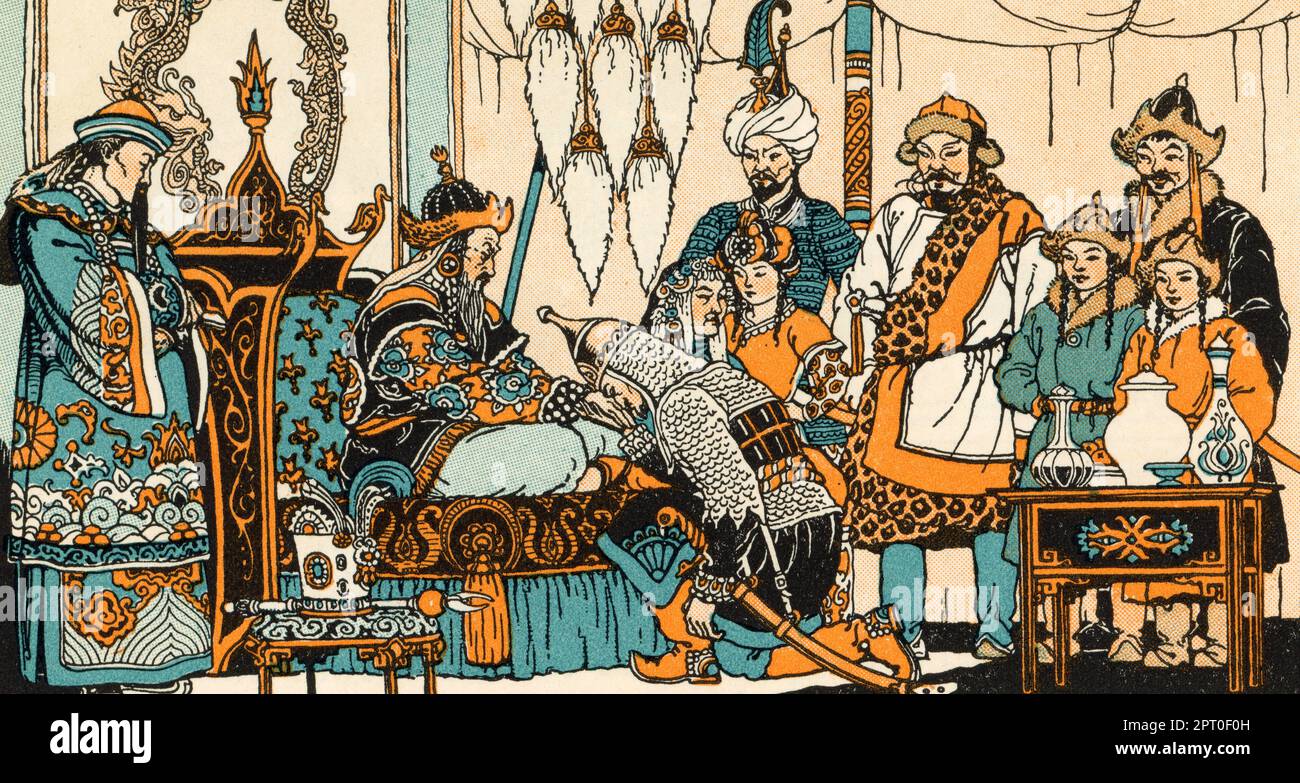 Genghis Khan (c1162-1227) holding court with his wife Börte (c1161-1230). By Donn Philip Crane (1878-1944). Their sons Jochi (c1182-1227), Chagatai (1183-1242), Ögedei (c1186-1241) and Tolui (c1191-1232) pay homage to their father. Stock Photohttps://www.alamy.com/image-license-details/?v=1https://www.alamy.com/genghis-khan-c1162-1227-holding-court-with-his-wife-brte-c1161-1230-by-donn-philip-crane-1878-1944-their-sons-jochi-c1182-1227-chagatai-1183-1242-gedei-c1186-1241-and-tolui-c1191-1232-pay-homage-to-their-father-image548284929.html
Genghis Khan (c1162-1227) holding court with his wife Börte (c1161-1230). By Donn Philip Crane (1878-1944). Their sons Jochi (c1182-1227), Chagatai (1183-1242), Ögedei (c1186-1241) and Tolui (c1191-1232) pay homage to their father. Stock Photohttps://www.alamy.com/image-license-details/?v=1https://www.alamy.com/genghis-khan-c1162-1227-holding-court-with-his-wife-brte-c1161-1230-by-donn-philip-crane-1878-1944-their-sons-jochi-c1182-1227-chagatai-1183-1242-gedei-c1186-1241-and-tolui-c1191-1232-pay-homage-to-their-father-image548284929.htmlRM2PT0F0H–Genghis Khan (c1162-1227) holding court with his wife Börte (c1161-1230). By Donn Philip Crane (1878-1944). Their sons Jochi (c1182-1227), Chagatai (1183-1242), Ögedei (c1186-1241) and Tolui (c1191-1232) pay homage to their father.
 Genghis Khan Statue Ulaanbaatar Mongolia Stock Photohttps://www.alamy.com/image-license-details/?v=1https://www.alamy.com/stock-photo-genghis-khan-statue-ulaanbaatar-mongolia-41979661.html
Genghis Khan Statue Ulaanbaatar Mongolia Stock Photohttps://www.alamy.com/image-license-details/?v=1https://www.alamy.com/stock-photo-genghis-khan-statue-ulaanbaatar-mongolia-41979661.htmlRMCC89DH–Genghis Khan Statue Ulaanbaatar Mongolia
 Genghis Khan Stock Photohttps://www.alamy.com/image-license-details/?v=1https://www.alamy.com/genghis-khan-image5075665.html
Genghis Khan Stock Photohttps://www.alamy.com/image-license-details/?v=1https://www.alamy.com/genghis-khan-image5075665.htmlRMANJXD2–Genghis Khan
 Genghis Khan (1162-1227). Emperor of Mogol Empire. Engraving. Colored. Stock Photohttps://www.alamy.com/image-license-details/?v=1https://www.alamy.com/genghis-khan-1162-1227-emperor-of-mogol-empire-engraving-colored-image67178054.html
Genghis Khan (1162-1227). Emperor of Mogol Empire. Engraving. Colored. Stock Photohttps://www.alamy.com/image-license-details/?v=1https://www.alamy.com/genghis-khan-1162-1227-emperor-of-mogol-empire-engraving-colored-image67178054.htmlRMDW8686–Genghis Khan (1162-1227). Emperor of Mogol Empire. Engraving. Colored.
 GENGHIS KHAN Stock Photohttps://www.alamy.com/image-license-details/?v=1https://www.alamy.com/genghis-khan-image68020435.html
GENGHIS KHAN Stock Photohttps://www.alamy.com/image-license-details/?v=1https://www.alamy.com/genghis-khan-image68020435.htmlRMDXJGN7–GENGHIS KHAN
 Map showing the Empire of Jengis Khan, or Genghis Khan, at his death, 1227. From A Short History of the World, published c.1936 Stock Photohttps://www.alamy.com/image-license-details/?v=1https://www.alamy.com/map-showing-the-empire-of-jengis-khan-or-genghis-khan-at-his-death-1227-from-a-short-history-of-the-world-published-c1936-image431592626.html
Map showing the Empire of Jengis Khan, or Genghis Khan, at his death, 1227. From A Short History of the World, published c.1936 Stock Photohttps://www.alamy.com/image-license-details/?v=1https://www.alamy.com/map-showing-the-empire-of-jengis-khan-or-genghis-khan-at-his-death-1227-from-a-short-history-of-the-world-published-c1936-image431592626.htmlRM2G24MPA–Map showing the Empire of Jengis Khan, or Genghis Khan, at his death, 1227. From A Short History of the World, published c.1936
 Sukhbaatar Square in the centre of Ulaanbaatar Ceremonial unveiling of the 5 million dollar statue of Genghis Khan Stock Photohttps://www.alamy.com/image-license-details/?v=1https://www.alamy.com/stock-photo-sukhbaatar-square-in-the-centre-of-ulaanbaatar-ceremonial-unveiling-19010993.html
Sukhbaatar Square in the centre of Ulaanbaatar Ceremonial unveiling of the 5 million dollar statue of Genghis Khan Stock Photohttps://www.alamy.com/image-license-details/?v=1https://www.alamy.com/stock-photo-sukhbaatar-square-in-the-centre-of-ulaanbaatar-ceremonial-unveiling-19010993.htmlRMB2X0M1–Sukhbaatar Square in the centre of Ulaanbaatar Ceremonial unveiling of the 5 million dollar statue of Genghis Khan
![The caption for this 1910 image reads: “The Mongolian ruler Odogei Khan [third] son of Genghis Khan—miniature from a collection in Paris” The Mongolian general and statesman Kublai Khan (also spelled Khubilai Khan) was the grandson of Genghis Khan. Kublai Khan (b.1215–d. 1294) conquered China and founded the Yuan, or Mongol, dynasty in China. Ögedei Khan (also Ogotai and Oktay) was born c. 1186 – and died 1241. He was the second Great Khan of the Mongol Empire by succeeding his father. He continued the expansion of the empire that his father had begun, and was the Great Khan when the Mongol Stock Photo The caption for this 1910 image reads: “The Mongolian ruler Odogei Khan [third] son of Genghis Khan—miniature from a collection in Paris” The Mongolian general and statesman Kublai Khan (also spelled Khubilai Khan) was the grandson of Genghis Khan. Kublai Khan (b.1215–d. 1294) conquered China and founded the Yuan, or Mongol, dynasty in China. Ögedei Khan (also Ogotai and Oktay) was born c. 1186 – and died 1241. He was the second Great Khan of the Mongol Empire by succeeding his father. He continued the expansion of the empire that his father had begun, and was the Great Khan when the Mongol Stock Photo](https://c8.alamy.com/comp/2JWG620/the-caption-for-this-1910-image-reads-the-mongolian-ruler-odogei-khan-third-son-of-genghis-khanminiature-from-a-collection-in-paris-the-mongolian-general-and-statesman-kublai-khan-also-spelled-khubilai-khan-was-the-grandson-of-genghis-khan-kublai-khan-b1215d-1294-conquered-china-and-founded-the-yuan-or-mongol-dynasty-in-china-gedei-khan-also-ogotai-and-oktay-was-born-c-1186-and-died-1241-he-was-the-second-great-khan-of-the-mongol-empire-by-succeeding-his-father-he-continued-the-expansion-of-the-empire-that-his-father-had-begun-and-was-the-great-khan-when-the-mongol-2JWG620.jpg) The caption for this 1910 image reads: “The Mongolian ruler Odogei Khan [third] son of Genghis Khan—miniature from a collection in Paris” The Mongolian general and statesman Kublai Khan (also spelled Khubilai Khan) was the grandson of Genghis Khan. Kublai Khan (b.1215–d. 1294) conquered China and founded the Yuan, or Mongol, dynasty in China. Ögedei Khan (also Ogotai and Oktay) was born c. 1186 – and died 1241. He was the second Great Khan of the Mongol Empire by succeeding his father. He continued the expansion of the empire that his father had begun, and was the Great Khan when the Mongol Stock Photohttps://www.alamy.com/image-license-details/?v=1https://www.alamy.com/the-caption-for-this-1910-image-reads-the-mongolian-ruler-odogei-khan-third-son-of-genghis-khanminiature-from-a-collection-in-paris-the-mongolian-general-and-statesman-kublai-khan-also-spelled-khubilai-khan-was-the-grandson-of-genghis-khan-kublai-khan-b1215d-1294-conquered-china-and-founded-the-yuan-or-mongol-dynasty-in-china-gedei-khan-also-ogotai-and-oktay-was-born-c-1186-and-died-1241-he-was-the-second-great-khan-of-the-mongol-empire-by-succeeding-his-father-he-continued-the-expansion-of-the-empire-that-his-father-had-begun-and-was-the-great-khan-when-the-mongol-image480402328.html
The caption for this 1910 image reads: “The Mongolian ruler Odogei Khan [third] son of Genghis Khan—miniature from a collection in Paris” The Mongolian general and statesman Kublai Khan (also spelled Khubilai Khan) was the grandson of Genghis Khan. Kublai Khan (b.1215–d. 1294) conquered China and founded the Yuan, or Mongol, dynasty in China. Ögedei Khan (also Ogotai and Oktay) was born c. 1186 – and died 1241. He was the second Great Khan of the Mongol Empire by succeeding his father. He continued the expansion of the empire that his father had begun, and was the Great Khan when the Mongol Stock Photohttps://www.alamy.com/image-license-details/?v=1https://www.alamy.com/the-caption-for-this-1910-image-reads-the-mongolian-ruler-odogei-khan-third-son-of-genghis-khanminiature-from-a-collection-in-paris-the-mongolian-general-and-statesman-kublai-khan-also-spelled-khubilai-khan-was-the-grandson-of-genghis-khan-kublai-khan-b1215d-1294-conquered-china-and-founded-the-yuan-or-mongol-dynasty-in-china-gedei-khan-also-ogotai-and-oktay-was-born-c-1186-and-died-1241-he-was-the-second-great-khan-of-the-mongol-empire-by-succeeding-his-father-he-continued-the-expansion-of-the-empire-that-his-father-had-begun-and-was-the-great-khan-when-the-mongol-image480402328.htmlRF2JWG620–The caption for this 1910 image reads: “The Mongolian ruler Odogei Khan [third] son of Genghis Khan—miniature from a collection in Paris” The Mongolian general and statesman Kublai Khan (also spelled Khubilai Khan) was the grandson of Genghis Khan. Kublai Khan (b.1215–d. 1294) conquered China and founded the Yuan, or Mongol, dynasty in China. Ögedei Khan (also Ogotai and Oktay) was born c. 1186 – and died 1241. He was the second Great Khan of the Mongol Empire by succeeding his father. He continued the expansion of the empire that his father had begun, and was the Great Khan when the Mongol
 Ulan Bator Mongolia statue of Genghis Khan Stock Photohttps://www.alamy.com/image-license-details/?v=1https://www.alamy.com/stock-photo-ulan-bator-mongolia-statue-of-genghis-khan-24595509.html
Ulan Bator Mongolia statue of Genghis Khan Stock Photohttps://www.alamy.com/image-license-details/?v=1https://www.alamy.com/stock-photo-ulan-bator-mongolia-statue-of-genghis-khan-24595509.htmlRFBC0BR1–Ulan Bator Mongolia statue of Genghis Khan
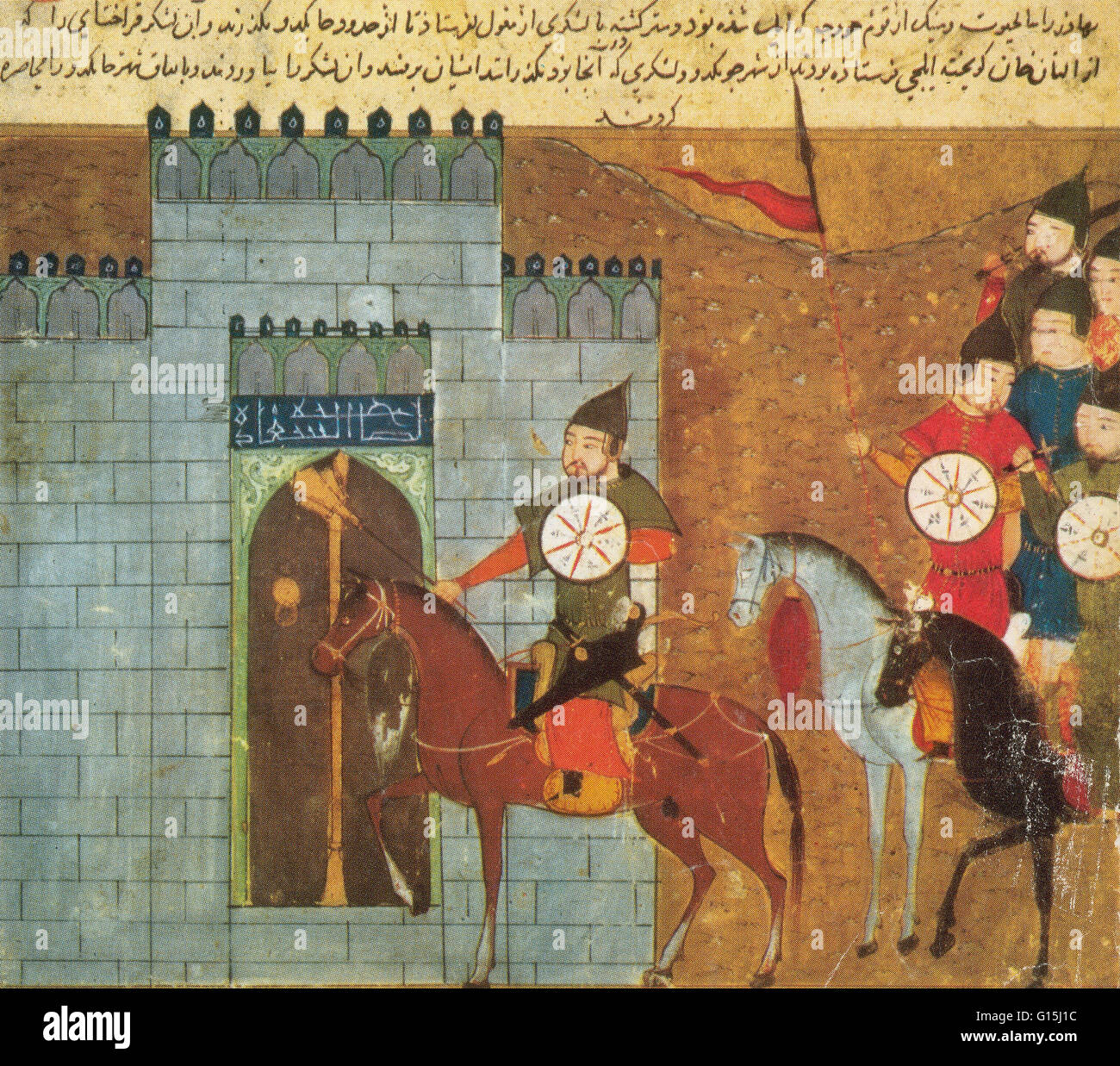 Genghis Khan (1162?-1227), born Temujin and also known by the temple name Taizu, was the founder and Great Khan (emperor) of the Mongol Empire, which became the largest contiguous empire in history after his death. He assumed leadership of the Mongola in Stock Photohttps://www.alamy.com/image-license-details/?v=1https://www.alamy.com/stock-photo-genghis-khan-1162-1227-born-temujin-and-also-known-by-the-temple-name-104000776.html
Genghis Khan (1162?-1227), born Temujin and also known by the temple name Taizu, was the founder and Great Khan (emperor) of the Mongol Empire, which became the largest contiguous empire in history after his death. He assumed leadership of the Mongola in Stock Photohttps://www.alamy.com/image-license-details/?v=1https://www.alamy.com/stock-photo-genghis-khan-1162-1227-born-temujin-and-also-known-by-the-temple-name-104000776.htmlRMG15J1C–Genghis Khan (1162?-1227), born Temujin and also known by the temple name Taizu, was the founder and Great Khan (emperor) of the Mongol Empire, which became the largest contiguous empire in history after his death. He assumed leadership of the Mongola in
 Statue of Genghis Khan in Atyrau, Kazakhstan Stock Photohttps://www.alamy.com/image-license-details/?v=1https://www.alamy.com/stock-photo-statue-of-genghis-khan-in-atyrau-kazakhstan-20722939.html
Statue of Genghis Khan in Atyrau, Kazakhstan Stock Photohttps://www.alamy.com/image-license-details/?v=1https://www.alamy.com/stock-photo-statue-of-genghis-khan-in-atyrau-kazakhstan-20722939.htmlRMB5M08Y–Statue of Genghis Khan in Atyrau, Kazakhstan
 Mongolia, Ulaan Baatar, Genghis Khan statue Stock Photohttps://www.alamy.com/image-license-details/?v=1https://www.alamy.com/stock-photo-mongolia-ulaan-baatar-genghis-khan-statue-39259660.html
Mongolia, Ulaan Baatar, Genghis Khan statue Stock Photohttps://www.alamy.com/image-license-details/?v=1https://www.alamy.com/stock-photo-mongolia-ulaan-baatar-genghis-khan-statue-39259660.htmlRMC7TC2M–Mongolia, Ulaan Baatar, Genghis Khan statue
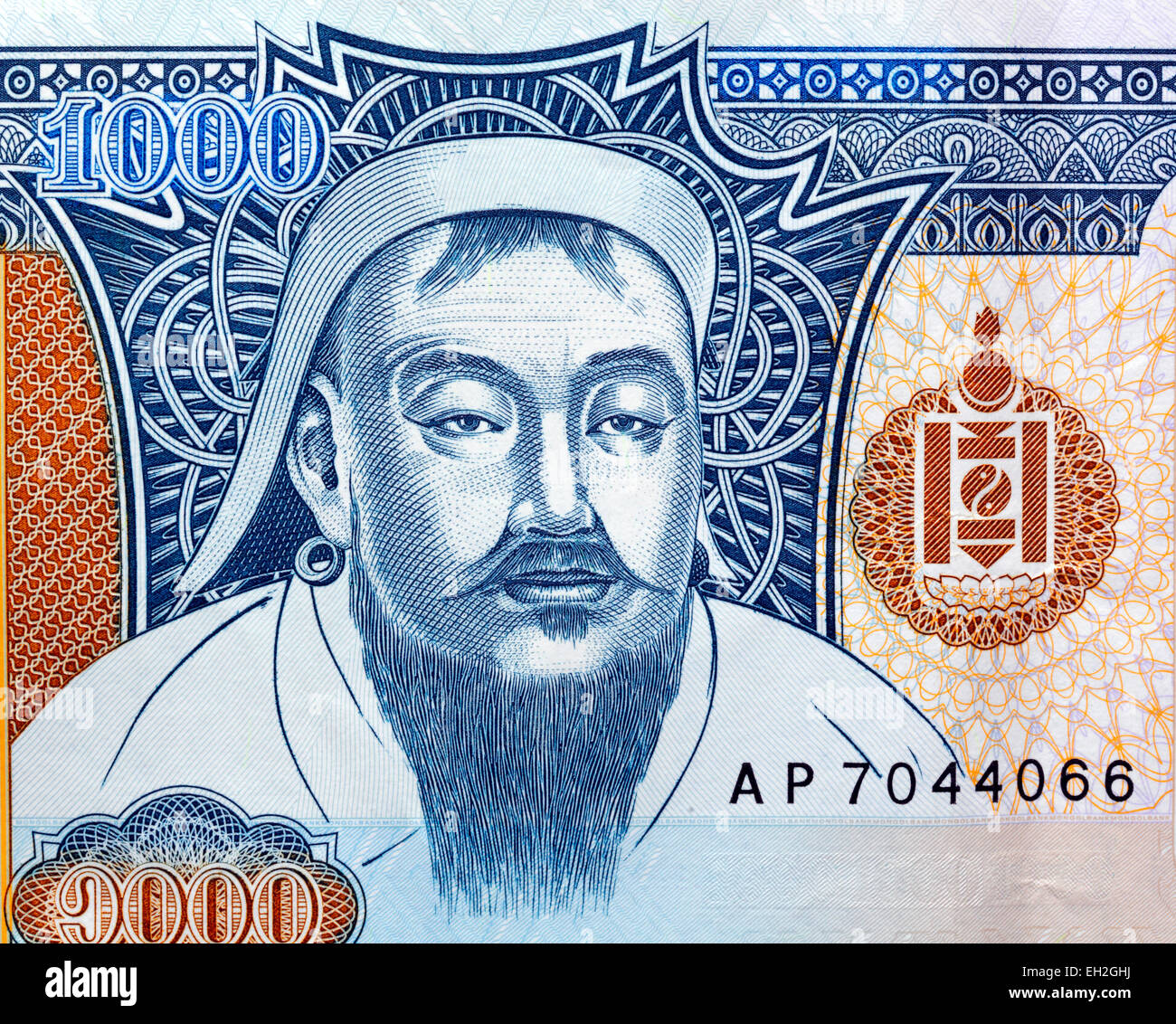 Genghis Khan from 1000 Togrog banknote, Mongolia, 2011 Stock Photohttps://www.alamy.com/image-license-details/?v=1https://www.alamy.com/stock-photo-genghis-khan-from-1000-togrog-banknote-mongolia-2011-79347566.html
Genghis Khan from 1000 Togrog banknote, Mongolia, 2011 Stock Photohttps://www.alamy.com/image-license-details/?v=1https://www.alamy.com/stock-photo-genghis-khan-from-1000-togrog-banknote-mongolia-2011-79347566.htmlRMEH2GHJ–Genghis Khan from 1000 Togrog banknote, Mongolia, 2011
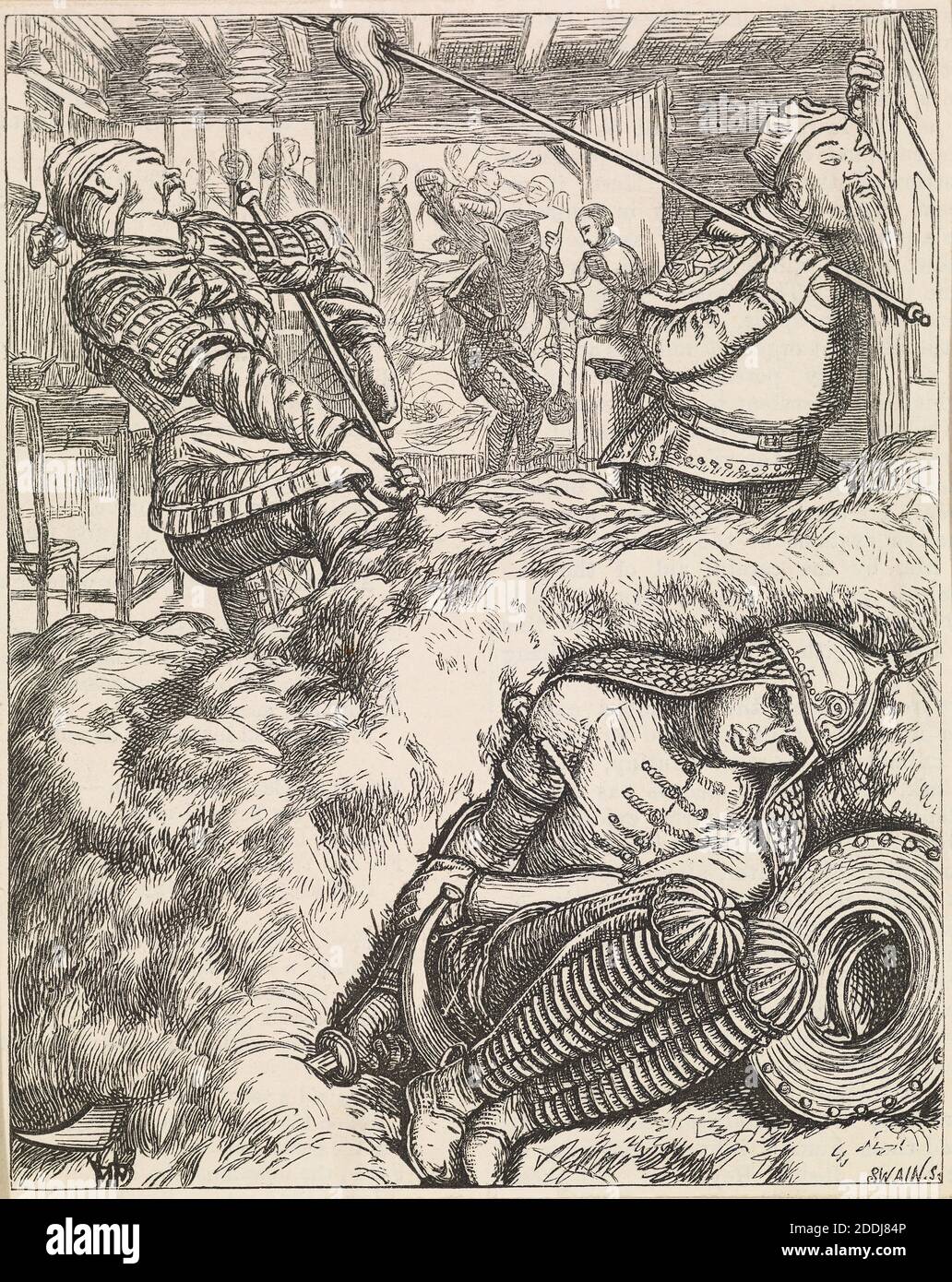 Wood engraving, Temujin, Published, 1860 Artist: William Holman Hunt Engraver: Joseph Swain, Illustration for Temujin, also known as Genghis Khan, Drawing, Ink, Sketch, Pre-Raphaelite, Illustration, Printing, Engraving Stock Photohttps://www.alamy.com/image-license-details/?v=1https://www.alamy.com/wood-engraving-temujin-published-1860-artist-william-holman-hunt-engraver-joseph-swain-illustration-for-temujin-also-known-as-genghis-khan-drawing-ink-sketch-pre-raphaelite-illustration-printing-engraving-image387020166.html
Wood engraving, Temujin, Published, 1860 Artist: William Holman Hunt Engraver: Joseph Swain, Illustration for Temujin, also known as Genghis Khan, Drawing, Ink, Sketch, Pre-Raphaelite, Illustration, Printing, Engraving Stock Photohttps://www.alamy.com/image-license-details/?v=1https://www.alamy.com/wood-engraving-temujin-published-1860-artist-william-holman-hunt-engraver-joseph-swain-illustration-for-temujin-also-known-as-genghis-khan-drawing-ink-sketch-pre-raphaelite-illustration-printing-engraving-image387020166.htmlRM2DDJ84P–Wood engraving, Temujin, Published, 1860 Artist: William Holman Hunt Engraver: Joseph Swain, Illustration for Temujin, also known as Genghis Khan, Drawing, Ink, Sketch, Pre-Raphaelite, Illustration, Printing, Engraving
 Prince Hetimandel receives at his court, Genghis Khan, (1158-1227), founder and first Great Khan (Emperor) of the Mongol Empire, which became the largest contiguous empire in history after his death. He came to power by uniting many of the nomadic tribes of Northeast Asia. After founding the Empire he launched the Mongol invasions that conquered most of Eurasia, reaching as far west as Poland in Europe and the Levant in the Middle East. Stock Photohttps://www.alamy.com/image-license-details/?v=1https://www.alamy.com/prince-hetimandel-receives-at-his-court-genghis-khan-1158-1227-founder-and-first-great-khan-emperor-of-the-mongol-empire-which-became-the-largest-contiguous-empire-in-history-after-his-death-he-came-to-power-by-uniting-many-of-the-nomadic-tribes-of-northeast-asia-after-founding-the-empire-he-launched-the-mongol-invasions-that-conquered-most-of-eurasia-reaching-as-far-west-as-poland-in-europe-and-the-levant-in-the-middle-east-image417856504.html
Prince Hetimandel receives at his court, Genghis Khan, (1158-1227), founder and first Great Khan (Emperor) of the Mongol Empire, which became the largest contiguous empire in history after his death. He came to power by uniting many of the nomadic tribes of Northeast Asia. After founding the Empire he launched the Mongol invasions that conquered most of Eurasia, reaching as far west as Poland in Europe and the Levant in the Middle East. Stock Photohttps://www.alamy.com/image-license-details/?v=1https://www.alamy.com/prince-hetimandel-receives-at-his-court-genghis-khan-1158-1227-founder-and-first-great-khan-emperor-of-the-mongol-empire-which-became-the-largest-contiguous-empire-in-history-after-his-death-he-came-to-power-by-uniting-many-of-the-nomadic-tribes-of-northeast-asia-after-founding-the-empire-he-launched-the-mongol-invasions-that-conquered-most-of-eurasia-reaching-as-far-west-as-poland-in-europe-and-the-levant-in-the-middle-east-image417856504.htmlRM2F7R06G–Prince Hetimandel receives at his court, Genghis Khan, (1158-1227), founder and first Great Khan (Emperor) of the Mongol Empire, which became the largest contiguous empire in history after his death. He came to power by uniting many of the nomadic tribes of Northeast Asia. After founding the Empire he launched the Mongol invasions that conquered most of Eurasia, reaching as far west as Poland in Europe and the Levant in the Middle East.
 Genghis Khan, Mongol ruler, founder of the Mongol Empire. Stock Photohttps://www.alamy.com/image-license-details/?v=1https://www.alamy.com/genghis-khan-mongol-ruler-founder-of-the-mongol-empire-image247137964.html
Genghis Khan, Mongol ruler, founder of the Mongol Empire. Stock Photohttps://www.alamy.com/image-license-details/?v=1https://www.alamy.com/genghis-khan-mongol-ruler-founder-of-the-mongol-empire-image247137964.htmlRMTA22YT–Genghis Khan, Mongol ruler, founder of the Mongol Empire.
 Mongolia: Genghis Khan (r.1206-1227), 1st Khagan of the Mongol Empire, statue in Ulan Bataar, Mongolia. Genghis Khan (1162–1227), born Borjigin Temujin, was the founder, Khan (ruler) and Khagan (emperor) of the Mongol Empire, which became the largest contiguous empire in history after his death. He came to power by uniting many of the nomadic tribes of northeast Asia. After founding the Mongol Empire and being proclaimed 'Genghis Khan', he began the Mongol invasions that would ultimately result in the conquest of most of Eurasia. Stock Photohttps://www.alamy.com/image-license-details/?v=1https://www.alamy.com/mongolia-genghis-khan-r1206-1227-1st-khagan-of-the-mongol-empire-statue-in-ulan-bataar-mongolia-genghis-khan-11621227-born-borjigin-temujin-was-the-founder-khan-ruler-and-khagan-emperor-of-the-mongol-empire-which-became-the-largest-contiguous-empire-in-history-after-his-death-he-came-to-power-by-uniting-many-of-the-nomadic-tribes-of-northeast-asia-after-founding-the-mongol-empire-and-being-proclaimed-genghis-khan-he-began-the-mongol-invasions-that-would-ultimately-result-in-the-conquest-of-most-of-eurasia-image344230573.html
Mongolia: Genghis Khan (r.1206-1227), 1st Khagan of the Mongol Empire, statue in Ulan Bataar, Mongolia. Genghis Khan (1162–1227), born Borjigin Temujin, was the founder, Khan (ruler) and Khagan (emperor) of the Mongol Empire, which became the largest contiguous empire in history after his death. He came to power by uniting many of the nomadic tribes of northeast Asia. After founding the Mongol Empire and being proclaimed 'Genghis Khan', he began the Mongol invasions that would ultimately result in the conquest of most of Eurasia. Stock Photohttps://www.alamy.com/image-license-details/?v=1https://www.alamy.com/mongolia-genghis-khan-r1206-1227-1st-khagan-of-the-mongol-empire-statue-in-ulan-bataar-mongolia-genghis-khan-11621227-born-borjigin-temujin-was-the-founder-khan-ruler-and-khagan-emperor-of-the-mongol-empire-which-became-the-largest-contiguous-empire-in-history-after-his-death-he-came-to-power-by-uniting-many-of-the-nomadic-tribes-of-northeast-asia-after-founding-the-mongol-empire-and-being-proclaimed-genghis-khan-he-began-the-mongol-invasions-that-would-ultimately-result-in-the-conquest-of-most-of-eurasia-image344230573.htmlRM2B011H1–Mongolia: Genghis Khan (r.1206-1227), 1st Khagan of the Mongol Empire, statue in Ulan Bataar, Mongolia. Genghis Khan (1162–1227), born Borjigin Temujin, was the founder, Khan (ruler) and Khagan (emperor) of the Mongol Empire, which became the largest contiguous empire in history after his death. He came to power by uniting many of the nomadic tribes of northeast Asia. After founding the Mongol Empire and being proclaimed 'Genghis Khan', he began the Mongol invasions that would ultimately result in the conquest of most of Eurasia.
 Chinggis Khan (Genghis Khan) statute, Mongolia Stock Photohttps://www.alamy.com/image-license-details/?v=1https://www.alamy.com/stock-photo-chinggis-khan-genghis-khan-statute-mongolia-58701251.html
Chinggis Khan (Genghis Khan) statute, Mongolia Stock Photohttps://www.alamy.com/image-license-details/?v=1https://www.alamy.com/stock-photo-chinggis-khan-genghis-khan-statute-mongolia-58701251.htmlRFDBE217–Chinggis Khan (Genghis Khan) statute, Mongolia
 GENGHIS KHAN -1964 Stock Photohttps://www.alamy.com/image-license-details/?v=1https://www.alamy.com/stock-photo-genghis-khan-1964-29249383.html
GENGHIS KHAN -1964 Stock Photohttps://www.alamy.com/image-license-details/?v=1https://www.alamy.com/stock-photo-genghis-khan-1964-29249383.htmlRMBKGBTR–GENGHIS KHAN -1964
 The marriage of Temujin and Borte. By Donn Philip Crane (1878-1944). When Temujin (later Genghis Khan) was eight years old, his father, Yesugei, betrothed him to Borte the daughter of an Onggirat chieftain. At fifteen Temujin returned to marry her. Stock Photohttps://www.alamy.com/image-license-details/?v=1https://www.alamy.com/the-marriage-of-temujin-and-borte-by-donn-philip-crane-1878-1944-when-temujin-later-genghis-khan-was-eight-years-old-his-father-yesugei-betrothed-him-to-borte-the-daughter-of-an-onggirat-chieftain-at-fifteen-temujin-returned-to-marry-her-image547512156.html
The marriage of Temujin and Borte. By Donn Philip Crane (1878-1944). When Temujin (later Genghis Khan) was eight years old, his father, Yesugei, betrothed him to Borte the daughter of an Onggirat chieftain. At fifteen Temujin returned to marry her. Stock Photohttps://www.alamy.com/image-license-details/?v=1https://www.alamy.com/the-marriage-of-temujin-and-borte-by-donn-philip-crane-1878-1944-when-temujin-later-genghis-khan-was-eight-years-old-his-father-yesugei-betrothed-him-to-borte-the-daughter-of-an-onggirat-chieftain-at-fifteen-temujin-returned-to-marry-her-image547512156.htmlRM2PPN99G–The marriage of Temujin and Borte. By Donn Philip Crane (1878-1944). When Temujin (later Genghis Khan) was eight years old, his father, Yesugei, betrothed him to Borte the daughter of an Onggirat chieftain. At fifteen Temujin returned to marry her.
 Genghis Khan Statue Ulaanbaatar Mongolia Stock Photohttps://www.alamy.com/image-license-details/?v=1https://www.alamy.com/stock-photo-genghis-khan-statue-ulaanbaatar-mongolia-41979685.html
Genghis Khan Statue Ulaanbaatar Mongolia Stock Photohttps://www.alamy.com/image-license-details/?v=1https://www.alamy.com/stock-photo-genghis-khan-statue-ulaanbaatar-mongolia-41979685.htmlRFCC89ED–Genghis Khan Statue Ulaanbaatar Mongolia
 Genghis Khan Stock Photohttps://www.alamy.com/image-license-details/?v=1https://www.alamy.com/genghis-khan-image3176740.html
Genghis Khan Stock Photohttps://www.alamy.com/image-license-details/?v=1https://www.alamy.com/genghis-khan-image3176740.htmlRMAYK925–Genghis Khan
 Giant statue of Ghenngis Khaan in Erdene, Töv Province, Mongolia. Chinggis Khan, Genghis Khan. Stock Photohttps://www.alamy.com/image-license-details/?v=1https://www.alamy.com/stock-photo-giant-statue-of-ghenngis-khaan-in-erdene-tv-province-mongolia-chinggis-86786881.html
Giant statue of Ghenngis Khaan in Erdene, Töv Province, Mongolia. Chinggis Khan, Genghis Khan. Stock Photohttps://www.alamy.com/image-license-details/?v=1https://www.alamy.com/stock-photo-giant-statue-of-ghenngis-khaan-in-erdene-tv-province-mongolia-chinggis-86786881.htmlRMF15DFD–Giant statue of Ghenngis Khaan in Erdene, Töv Province, Mongolia. Chinggis Khan, Genghis Khan.
 A statue of Genghis Khan (Chinggis Khan) in front of Mongolian parliament building at Sukhbaatar Square in Ulaanbaatar. Stock Photohttps://www.alamy.com/image-license-details/?v=1https://www.alamy.com/stock-photo-a-statue-of-genghis-khan-chinggis-khan-in-front-of-mongolian-parliament-29316946.html
A statue of Genghis Khan (Chinggis Khan) in front of Mongolian parliament building at Sukhbaatar Square in Ulaanbaatar. Stock Photohttps://www.alamy.com/image-license-details/?v=1https://www.alamy.com/stock-photo-a-statue-of-genghis-khan-chinggis-khan-in-front-of-mongolian-parliament-29316946.htmlRMBKKE1P–A statue of Genghis Khan (Chinggis Khan) in front of Mongolian parliament building at Sukhbaatar Square in Ulaanbaatar.
 Mongol Empire map at Genghis Khan's death in 1227 and at its greatest extent in 1279. Stock Photohttps://www.alamy.com/image-license-details/?v=1https://www.alamy.com/stock-photo-mongol-empire-map-at-genghis-khans-death-in-1227-and-at-its-greatest-79217283.html
Mongol Empire map at Genghis Khan's death in 1227 and at its greatest extent in 1279. Stock Photohttps://www.alamy.com/image-license-details/?v=1https://www.alamy.com/stock-photo-mongol-empire-map-at-genghis-khans-death-in-1227-and-at-its-greatest-79217283.htmlRFEGTJCK–Mongol Empire map at Genghis Khan's death in 1227 and at its greatest extent in 1279.
 shiny silver commemorative coin depicting the Mongol Genghis Khan, isolated on white background Stock Photohttps://www.alamy.com/image-license-details/?v=1https://www.alamy.com/stock-photo-shiny-silver-commemorative-coin-depicting-the-mongol-genghis-khan-41558152.html
shiny silver commemorative coin depicting the Mongol Genghis Khan, isolated on white background Stock Photohttps://www.alamy.com/image-license-details/?v=1https://www.alamy.com/stock-photo-shiny-silver-commemorative-coin-depicting-the-mongol-genghis-khan-41558152.htmlRFCBH3RM–shiny silver commemorative coin depicting the Mongol Genghis Khan, isolated on white background
 Kara-Korum old capital of Genghis Khan, Kara-Korum, Mongolia Asia Stock Photohttps://www.alamy.com/image-license-details/?v=1https://www.alamy.com/kara-korum-old-capital-of-genghis-khan-kara-korum-mongolia-asia-image9099676.html
Kara-Korum old capital of Genghis Khan, Kara-Korum, Mongolia Asia Stock Photohttps://www.alamy.com/image-license-details/?v=1https://www.alamy.com/kara-korum-old-capital-of-genghis-khan-kara-korum-mongolia-asia-image9099676.htmlRMAR38WD–Kara-Korum old capital of Genghis Khan, Kara-Korum, Mongolia Asia
 Statue of Genghis Khan at the Mausoleum, Ordos, Inner Mongolia, China Stock Photohttps://www.alamy.com/image-license-details/?v=1https://www.alamy.com/stock-photo-statue-of-genghis-khan-at-the-mausoleum-ordos-inner-mongolia-china-51606274.html
Statue of Genghis Khan at the Mausoleum, Ordos, Inner Mongolia, China Stock Photohttps://www.alamy.com/image-license-details/?v=1https://www.alamy.com/stock-photo-statue-of-genghis-khan-at-the-mausoleum-ordos-inner-mongolia-china-51606274.htmlRFCYXT96–Statue of Genghis Khan at the Mausoleum, Ordos, Inner Mongolia, China
 Genghis Khan equestrian statue, Genghis Khan theme park, Chinggis Khaan statue complex, Tsonjin Boldog, Mongolia Stock Photohttps://www.alamy.com/image-license-details/?v=1https://www.alamy.com/genghis-khan-equestrian-statue-genghis-khan-theme-park-chinggis-khaan-statue-complex-tsonjin-boldog-mongolia-image178127004.html
Genghis Khan equestrian statue, Genghis Khan theme park, Chinggis Khaan statue complex, Tsonjin Boldog, Mongolia Stock Photohttps://www.alamy.com/image-license-details/?v=1https://www.alamy.com/genghis-khan-equestrian-statue-genghis-khan-theme-park-chinggis-khaan-statue-complex-tsonjin-boldog-mongolia-image178127004.htmlRFM9PAPM–Genghis Khan equestrian statue, Genghis Khan theme park, Chinggis Khaan statue complex, Tsonjin Boldog, Mongolia
 Statue of Genghis Khan in Atyrau, Kazakhstan Stock Photohttps://www.alamy.com/image-license-details/?v=1https://www.alamy.com/stock-photo-statue-of-genghis-khan-in-atyrau-kazakhstan-20735681.html
Statue of Genghis Khan in Atyrau, Kazakhstan Stock Photohttps://www.alamy.com/image-license-details/?v=1https://www.alamy.com/stock-photo-statue-of-genghis-khan-in-atyrau-kazakhstan-20735681.htmlRMB5MGG1–Statue of Genghis Khan in Atyrau, Kazakhstan
 TELLY SAVALAS, GENGHIS KHAN, 1965 Stock Photohttps://www.alamy.com/image-license-details/?v=1https://www.alamy.com/telly-savalas-genghis-khan-1965-image239590543.html
TELLY SAVALAS, GENGHIS KHAN, 1965 Stock Photohttps://www.alamy.com/image-license-details/?v=1https://www.alamy.com/telly-savalas-genghis-khan-1965-image239590543.htmlRMRWP853–TELLY SAVALAS, GENGHIS KHAN, 1965
 Art inspired by Portrait of Genghis Khan, Ink and color on silk, China, 1644-1911, Qing Dynasty, Qing Dynasty, 32 1/2 x 21 5/8 in., 82.5 x 54.9 cm, Genghis, Genghis Khan, Khan, Temujin, Classic works modernized by Artotop with a splash of modernity. Shapes, color and value, eye-catching visual impact on art. Emotions through freedom of artworks in a contemporary way. A timeless message pursuing a wildly creative new direction. Artists turning to the digital medium and creating the Artotop NFT Stock Photohttps://www.alamy.com/image-license-details/?v=1https://www.alamy.com/art-inspired-by-portrait-of-genghis-khan-ink-and-color-on-silk-china-1644-1911-qing-dynasty-qing-dynasty-32-12-x-21-58-in-825-x-549-cm-genghis-genghis-khan-khan-temujin-classic-works-modernized-by-artotop-with-a-splash-of-modernity-shapes-color-and-value-eye-catching-visual-impact-on-art-emotions-through-freedom-of-artworks-in-a-contemporary-way-a-timeless-message-pursuing-a-wildly-creative-new-direction-artists-turning-to-the-digital-medium-and-creating-the-artotop-nft-image459566417.html
Art inspired by Portrait of Genghis Khan, Ink and color on silk, China, 1644-1911, Qing Dynasty, Qing Dynasty, 32 1/2 x 21 5/8 in., 82.5 x 54.9 cm, Genghis, Genghis Khan, Khan, Temujin, Classic works modernized by Artotop with a splash of modernity. Shapes, color and value, eye-catching visual impact on art. Emotions through freedom of artworks in a contemporary way. A timeless message pursuing a wildly creative new direction. Artists turning to the digital medium and creating the Artotop NFT Stock Photohttps://www.alamy.com/image-license-details/?v=1https://www.alamy.com/art-inspired-by-portrait-of-genghis-khan-ink-and-color-on-silk-china-1644-1911-qing-dynasty-qing-dynasty-32-12-x-21-58-in-825-x-549-cm-genghis-genghis-khan-khan-temujin-classic-works-modernized-by-artotop-with-a-splash-of-modernity-shapes-color-and-value-eye-catching-visual-impact-on-art-emotions-through-freedom-of-artworks-in-a-contemporary-way-a-timeless-message-pursuing-a-wildly-creative-new-direction-artists-turning-to-the-digital-medium-and-creating-the-artotop-nft-image459566417.htmlRF2HKK1J9–Art inspired by Portrait of Genghis Khan, Ink and color on silk, China, 1644-1911, Qing Dynasty, Qing Dynasty, 32 1/2 x 21 5/8 in., 82.5 x 54.9 cm, Genghis, Genghis Khan, Khan, Temujin, Classic works modernized by Artotop with a splash of modernity. Shapes, color and value, eye-catching visual impact on art. Emotions through freedom of artworks in a contemporary way. A timeless message pursuing a wildly creative new direction. Artists turning to the digital medium and creating the Artotop NFT
 ULAAN BAATAR, MONGOLIA Statue of Genghis Khan in front of Parliament Building, Sukhbaatar Square. Stock Photohttps://www.alamy.com/image-license-details/?v=1https://www.alamy.com/stock-photo-ulaan-baatar-mongolia-statue-of-genghis-khan-in-front-of-parliament-79109545.html
ULAAN BAATAR, MONGOLIA Statue of Genghis Khan in front of Parliament Building, Sukhbaatar Square. Stock Photohttps://www.alamy.com/image-license-details/?v=1https://www.alamy.com/stock-photo-ulaan-baatar-mongolia-statue-of-genghis-khan-in-front-of-parliament-79109545.htmlRFEGKN0W–ULAAN BAATAR, MONGOLIA Statue of Genghis Khan in front of Parliament Building, Sukhbaatar Square.
 Mongolia, Ulaan Baatar, Genghis Khan statue Stock Photohttps://www.alamy.com/image-license-details/?v=1https://www.alamy.com/stock-photo-mongolia-ulaan-baatar-genghis-khan-statue-39259645.html
Mongolia, Ulaan Baatar, Genghis Khan statue Stock Photohttps://www.alamy.com/image-license-details/?v=1https://www.alamy.com/stock-photo-mongolia-ulaan-baatar-genghis-khan-statue-39259645.htmlRMC7TC25–Mongolia, Ulaan Baatar, Genghis Khan statue
 Genghis Khan - Mongolia Stock Photohttps://www.alamy.com/image-license-details/?v=1https://www.alamy.com/stock-photo-genghis-khan-mongolia-87157371.html
Genghis Khan - Mongolia Stock Photohttps://www.alamy.com/image-license-details/?v=1https://www.alamy.com/stock-photo-genghis-khan-mongolia-87157371.htmlRFF1PA37–Genghis Khan - Mongolia
 Mongolia: Genghis Khan with his wife Borte Ujin, dividing his Empire between his four sons. Mughal court painting by Basawan (fl. 1556-1600), c. 1596. Borte Ujin (c.1162 - 1230) was the first wife of Genghis Khan, the founder of the Mongol Empire. Börte became the head of the first Court of Genghis Khan, and Grand Empress of his Empire. Little is known about the details of her early life, but she was betrothed to him at a young age, married at 17, and then kidnapped by a rival tribe. The decision by her husband to rescue her may have been one of the key decisions that started him on his path Stock Photohttps://www.alamy.com/image-license-details/?v=1https://www.alamy.com/mongolia-genghis-khan-with-his-wife-borte-ujin-dividing-his-empire-between-his-four-sons-mughal-court-painting-by-basawan-fl-1556-1600-c-1596-borte-ujin-c1162-1230-was-the-first-wife-of-genghis-khan-the-founder-of-the-mongol-empire-brte-became-the-head-of-the-first-court-of-genghis-khan-and-grand-empress-of-his-empire-little-is-known-about-the-details-of-her-early-life-but-she-was-betrothed-to-him-at-a-young-age-married-at-17-and-then-kidnapped-by-a-rival-tribe-the-decision-by-her-husband-to-rescue-her-may-have-been-one-of-the-key-decisions-that-started-him-on-his-path-image344230174.html
Mongolia: Genghis Khan with his wife Borte Ujin, dividing his Empire between his four sons. Mughal court painting by Basawan (fl. 1556-1600), c. 1596. Borte Ujin (c.1162 - 1230) was the first wife of Genghis Khan, the founder of the Mongol Empire. Börte became the head of the first Court of Genghis Khan, and Grand Empress of his Empire. Little is known about the details of her early life, but she was betrothed to him at a young age, married at 17, and then kidnapped by a rival tribe. The decision by her husband to rescue her may have been one of the key decisions that started him on his path Stock Photohttps://www.alamy.com/image-license-details/?v=1https://www.alamy.com/mongolia-genghis-khan-with-his-wife-borte-ujin-dividing-his-empire-between-his-four-sons-mughal-court-painting-by-basawan-fl-1556-1600-c-1596-borte-ujin-c1162-1230-was-the-first-wife-of-genghis-khan-the-founder-of-the-mongol-empire-brte-became-the-head-of-the-first-court-of-genghis-khan-and-grand-empress-of-his-empire-little-is-known-about-the-details-of-her-early-life-but-she-was-betrothed-to-him-at-a-young-age-married-at-17-and-then-kidnapped-by-a-rival-tribe-the-decision-by-her-husband-to-rescue-her-may-have-been-one-of-the-key-decisions-that-started-him-on-his-path-image344230174.htmlRM2B0112P–Mongolia: Genghis Khan with his wife Borte Ujin, dividing his Empire between his four sons. Mughal court painting by Basawan (fl. 1556-1600), c. 1596. Borte Ujin (c.1162 - 1230) was the first wife of Genghis Khan, the founder of the Mongol Empire. Börte became the head of the first Court of Genghis Khan, and Grand Empress of his Empire. Little is known about the details of her early life, but she was betrothed to him at a young age, married at 17, and then kidnapped by a rival tribe. The decision by her husband to rescue her may have been one of the key decisions that started him on his path
 Genghis Khan, 14th century portrait Stock Photohttps://www.alamy.com/image-license-details/?v=1https://www.alamy.com/genghis-khan-14th-century-portrait-image68552842.html
Genghis Khan, 14th century portrait Stock Photohttps://www.alamy.com/image-license-details/?v=1https://www.alamy.com/genghis-khan-14th-century-portrait-image68552842.htmlRMDYERRP–Genghis Khan, 14th century portrait
 GENGHIS KHAN -1964 Stock Photohttps://www.alamy.com/image-license-details/?v=1https://www.alamy.com/stock-photo-genghis-khan-1964-29249375.html
GENGHIS KHAN -1964 Stock Photohttps://www.alamy.com/image-license-details/?v=1https://www.alamy.com/stock-photo-genghis-khan-1964-29249375.htmlRMBKGBTF–GENGHIS KHAN -1964
 'Conquests of Genghis Khan in Asia and Europe from the Pacific Ocean to the Black Sea', c1937. A map showing the scope of the Mongol Empire of Genghis Khan (c1162-1227). Genghis Khan was the founder and first khagan of the Mongol Empire, which later became the largest contiguous land empire in history. Stock Photohttps://www.alamy.com/image-license-details/?v=1https://www.alamy.com/conquests-of-genghis-khan-in-asia-and-europe-from-the-pacific-ocean-to-the-black-sea-c1937-a-map-showing-the-scope-of-the-mongol-empire-of-genghis-khan-c1162-1227-genghis-khan-was-the-founder-and-first-khagan-of-the-mongol-empire-which-later-became-the-largest-contiguous-land-empire-in-history-image548287102.html
'Conquests of Genghis Khan in Asia and Europe from the Pacific Ocean to the Black Sea', c1937. A map showing the scope of the Mongol Empire of Genghis Khan (c1162-1227). Genghis Khan was the founder and first khagan of the Mongol Empire, which later became the largest contiguous land empire in history. Stock Photohttps://www.alamy.com/image-license-details/?v=1https://www.alamy.com/conquests-of-genghis-khan-in-asia-and-europe-from-the-pacific-ocean-to-the-black-sea-c1937-a-map-showing-the-scope-of-the-mongol-empire-of-genghis-khan-c1162-1227-genghis-khan-was-the-founder-and-first-khagan-of-the-mongol-empire-which-later-became-the-largest-contiguous-land-empire-in-history-image548287102.htmlRM2PT0HP6–'Conquests of Genghis Khan in Asia and Europe from the Pacific Ocean to the Black Sea', c1937. A map showing the scope of the Mongol Empire of Genghis Khan (c1162-1227). Genghis Khan was the founder and first khagan of the Mongol Empire, which later became the largest contiguous land empire in history.
 Genghis Khan Statue Ulaanbaatar Mongolia Stock Photohttps://www.alamy.com/image-license-details/?v=1https://www.alamy.com/stock-photo-genghis-khan-statue-ulaanbaatar-mongolia-41979674.html
Genghis Khan Statue Ulaanbaatar Mongolia Stock Photohttps://www.alamy.com/image-license-details/?v=1https://www.alamy.com/stock-photo-genghis-khan-statue-ulaanbaatar-mongolia-41979674.htmlRFCC89E2–Genghis Khan Statue Ulaanbaatar Mongolia
 Genghis Khan invades the West Stock Photohttps://www.alamy.com/image-license-details/?v=1https://www.alamy.com/genghis-khan-invades-the-west-image560830555.html
Genghis Khan invades the West Stock Photohttps://www.alamy.com/image-license-details/?v=1https://www.alamy.com/genghis-khan-invades-the-west-image560830555.htmlRM2RGC12K–Genghis Khan invades the West
 . English: Tulsi , Madhu Toda Mongke and His Mongol Horde, Folio from a Chingiznama (History of Genghis Khan), 1596 Painting; Watercolor, Opaque watercolor, gold, and ink on paper, Sheet: 15 x 10 in. (38.1 x 25.4 cm); Image: 12 3/8 x 8 in. (31.4 x 20.3 cm) From the Nasli and Alice Heeramaneck Collection, Museum Associates Purchase (M.78.9.8) South and Southeast Asian Art Department. . 1596. 1198 Toda Mongke and His Mongol Horde Stock Photohttps://www.alamy.com/image-license-details/?v=1https://www.alamy.com/english-tulsi-madhu-toda-mongke-and-his-mongol-horde-folio-from-a-chingiznama-history-of-genghis-khan-1596-painting-watercolor-opaque-watercolor-gold-and-ink-on-paper-sheet-15-x-10-in-381-x-254-cm-image-12-38-x-8-in-314-x-203-cm-from-the-nasli-and-alice-heeramaneck-collection-museum-associates-purchase-m7898-south-and-southeast-asian-art-department-1596-1198-toda-mongke-and-his-mongol-horde-image185603010.html
. English: Tulsi , Madhu Toda Mongke and His Mongol Horde, Folio from a Chingiznama (History of Genghis Khan), 1596 Painting; Watercolor, Opaque watercolor, gold, and ink on paper, Sheet: 15 x 10 in. (38.1 x 25.4 cm); Image: 12 3/8 x 8 in. (31.4 x 20.3 cm) From the Nasli and Alice Heeramaneck Collection, Museum Associates Purchase (M.78.9.8) South and Southeast Asian Art Department. . 1596. 1198 Toda Mongke and His Mongol Horde Stock Photohttps://www.alamy.com/image-license-details/?v=1https://www.alamy.com/english-tulsi-madhu-toda-mongke-and-his-mongol-horde-folio-from-a-chingiznama-history-of-genghis-khan-1596-painting-watercolor-opaque-watercolor-gold-and-ink-on-paper-sheet-15-x-10-in-381-x-254-cm-image-12-38-x-8-in-314-x-203-cm-from-the-nasli-and-alice-heeramaneck-collection-museum-associates-purchase-m7898-south-and-southeast-asian-art-department-1596-1198-toda-mongke-and-his-mongol-horde-image185603010.htmlRMMNXXEX–. English: Tulsi , Madhu Toda Mongke and His Mongol Horde, Folio from a Chingiznama (History of Genghis Khan), 1596 Painting; Watercolor, Opaque watercolor, gold, and ink on paper, Sheet: 15 x 10 in. (38.1 x 25.4 cm); Image: 12 3/8 x 8 in. (31.4 x 20.3 cm) From the Nasli and Alice Heeramaneck Collection, Museum Associates Purchase (M.78.9.8) South and Southeast Asian Art Department. . 1596. 1198 Toda Mongke and His Mongol Horde
 Portrait of Genghis Khan (1155/1162-1227) , founder and first Great Khan of the Mongol Empire Stock Photohttps://www.alamy.com/image-license-details/?v=1https://www.alamy.com/portrait-of-genghis-khan-11551162-1227-founder-and-first-great-khan-of-the-mongol-empire-image460450344.html
Portrait of Genghis Khan (1155/1162-1227) , founder and first Great Khan of the Mongol Empire Stock Photohttps://www.alamy.com/image-license-details/?v=1https://www.alamy.com/portrait-of-genghis-khan-11551162-1227-founder-and-first-great-khan-of-the-mongol-empire-image460450344.htmlRM2HN3934–Portrait of Genghis Khan (1155/1162-1227) , founder and first Great Khan of the Mongol Empire
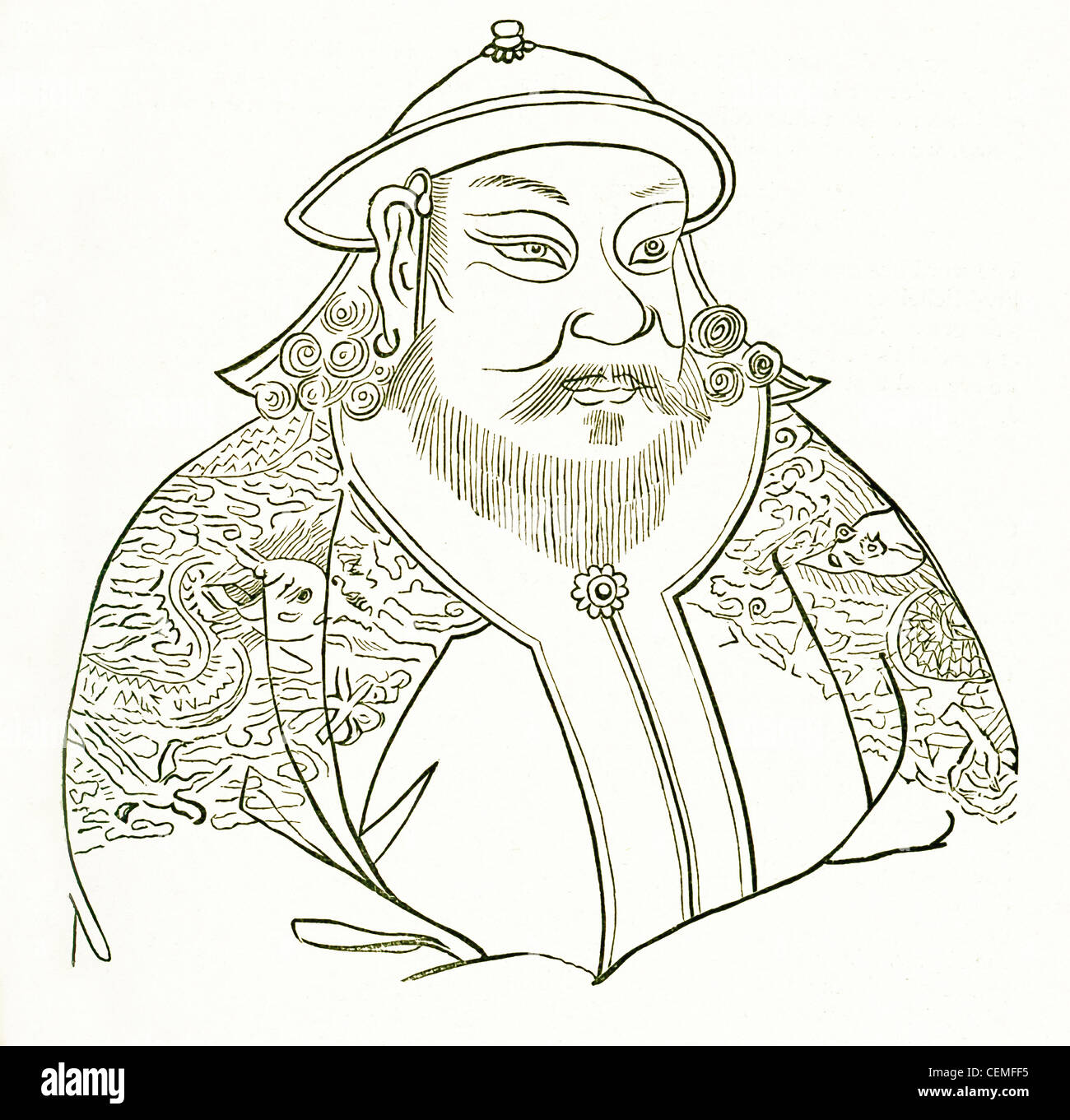 The Mongolian general and statesman Kublai Khan (also spelled Khubilai Khan) was the grandson of Genghis Khan. Stock Photohttps://www.alamy.com/image-license-details/?v=1https://www.alamy.com/stock-photo-the-mongolian-general-and-statesman-kublai-khan-also-spelled-khubilai-43477145.html
The Mongolian general and statesman Kublai Khan (also spelled Khubilai Khan) was the grandson of Genghis Khan. Stock Photohttps://www.alamy.com/image-license-details/?v=1https://www.alamy.com/stock-photo-the-mongolian-general-and-statesman-kublai-khan-also-spelled-khubilai-43477145.htmlRFCEMFF5–The Mongolian general and statesman Kublai Khan (also spelled Khubilai Khan) was the grandson of Genghis Khan.
 Portrait of Genghis Khan Stock Photohttps://www.alamy.com/image-license-details/?v=1https://www.alamy.com/stock-photo-portrait-of-genghis-khan-20695728.html
Portrait of Genghis Khan Stock Photohttps://www.alamy.com/image-license-details/?v=1https://www.alamy.com/stock-photo-portrait-of-genghis-khan-20695728.htmlRMB5JNH4–Portrait of Genghis Khan
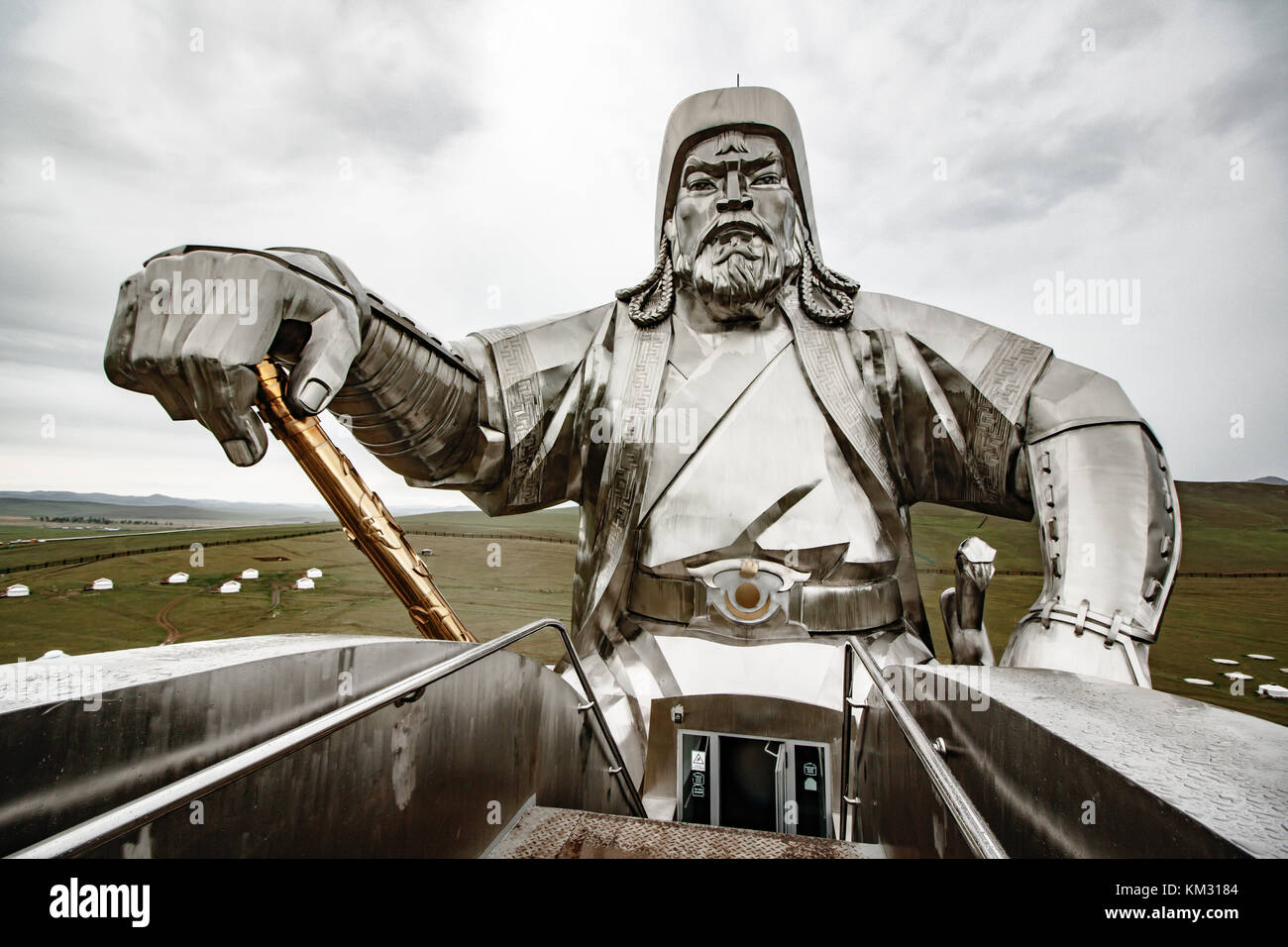 Giant Genghis Khan Equestrian Statue in Ulaanbaatar, Mongolia Stock Photohttps://www.alamy.com/image-license-details/?v=1https://www.alamy.com/stock-image-giant-genghis-khan-equestrian-statue-in-ulaanbaatar-mongolia-167253300.html
Giant Genghis Khan Equestrian Statue in Ulaanbaatar, Mongolia Stock Photohttps://www.alamy.com/image-license-details/?v=1https://www.alamy.com/stock-image-giant-genghis-khan-equestrian-statue-in-ulaanbaatar-mongolia-167253300.htmlRFKM3184–Giant Genghis Khan Equestrian Statue in Ulaanbaatar, Mongolia
 Genghis Khan Mausoleum, Ordos, Inner Mongolia, China Stock Photohttps://www.alamy.com/image-license-details/?v=1https://www.alamy.com/stock-photo-genghis-khan-mausoleum-ordos-inner-mongolia-china-41922329.html
Genghis Khan Mausoleum, Ordos, Inner Mongolia, China Stock Photohttps://www.alamy.com/image-license-details/?v=1https://www.alamy.com/stock-photo-genghis-khan-mausoleum-ordos-inner-mongolia-china-41922329.htmlRMCC5MA1–Genghis Khan Mausoleum, Ordos, Inner Mongolia, China
 Ancient fireplace stones, Site of a 12th-century camp of Ghengis Khan and his troops, National Park Altyn-Emel, Almaty region, Stock Photohttps://www.alamy.com/image-license-details/?v=1https://www.alamy.com/stock-photo-ancient-fireplace-stones-site-of-a-12th-century-camp-of-ghengis-khan-126493751.html
Ancient fireplace stones, Site of a 12th-century camp of Ghengis Khan and his troops, National Park Altyn-Emel, Almaty region, Stock Photohttps://www.alamy.com/image-license-details/?v=1https://www.alamy.com/stock-photo-ancient-fireplace-stones-site-of-a-12th-century-camp-of-ghengis-khan-126493751.htmlRFH9P81Y–Ancient fireplace stones, Site of a 12th-century camp of Ghengis Khan and his troops, National Park Altyn-Emel, Almaty region,
 Statue of Genghis Khan in Sukhbaatar Square, Ulaan Baatar, Mongolia Stock Photohttps://www.alamy.com/image-license-details/?v=1https://www.alamy.com/stock-photo-statue-of-genghis-khan-in-sukhbaatar-square-ulaan-baatar-mongolia-20735789.html
Statue of Genghis Khan in Sukhbaatar Square, Ulaan Baatar, Mongolia Stock Photohttps://www.alamy.com/image-license-details/?v=1https://www.alamy.com/stock-photo-statue-of-genghis-khan-in-sukhbaatar-square-ulaan-baatar-mongolia-20735789.htmlRMB5MGKW–Statue of Genghis Khan in Sukhbaatar Square, Ulaan Baatar, Mongolia
 London, Marble Arch Statue of Genghis Khan by Dashi Namdakov April 2012 Stock Photohttps://www.alamy.com/image-license-details/?v=1https://www.alamy.com/stock-photo-london-marble-arch-statue-of-genghis-khan-by-dashi-namdakov-april-47956358.html
London, Marble Arch Statue of Genghis Khan by Dashi Namdakov April 2012 Stock Photohttps://www.alamy.com/image-license-details/?v=1https://www.alamy.com/stock-photo-london-marble-arch-statue-of-genghis-khan-by-dashi-namdakov-april-47956358.htmlRMCP0GR2–London, Marble Arch Statue of Genghis Khan by Dashi Namdakov April 2012
 Art inspired by Siege of Baghdad, folio from an illuminated manuscript of the History of Genghis Khan, Khem Karan, Indian, active c.1580-c.1605, Indian, Mughal period, 1526-1858, reign of Akbar, Mughal, reigned 1556-1605, 1596, Ink, opaque watercolor, and gold on paper, Made in Lahore, Classic works modernized by Artotop with a splash of modernity. Shapes, color and value, eye-catching visual impact on art. Emotions through freedom of artworks in a contemporary way. A timeless message pursuing a wildly creative new direction. Artists turning to the digital medium and creating the Artotop NFT Stock Photohttps://www.alamy.com/image-license-details/?v=1https://www.alamy.com/art-inspired-by-siege-of-baghdad-folio-from-an-illuminated-manuscript-of-the-history-of-genghis-khan-khem-karan-indian-active-c1580-c1605-indian-mughal-period-1526-1858-reign-of-akbar-mughal-reigned-1556-1605-1596-ink-opaque-watercolor-and-gold-on-paper-made-in-lahore-classic-works-modernized-by-artotop-with-a-splash-of-modernity-shapes-color-and-value-eye-catching-visual-impact-on-art-emotions-through-freedom-of-artworks-in-a-contemporary-way-a-timeless-message-pursuing-a-wildly-creative-new-direction-artists-turning-to-the-digital-medium-and-creating-the-artotop-nft-image459594898.html
Art inspired by Siege of Baghdad, folio from an illuminated manuscript of the History of Genghis Khan, Khem Karan, Indian, active c.1580-c.1605, Indian, Mughal period, 1526-1858, reign of Akbar, Mughal, reigned 1556-1605, 1596, Ink, opaque watercolor, and gold on paper, Made in Lahore, Classic works modernized by Artotop with a splash of modernity. Shapes, color and value, eye-catching visual impact on art. Emotions through freedom of artworks in a contemporary way. A timeless message pursuing a wildly creative new direction. Artists turning to the digital medium and creating the Artotop NFT Stock Photohttps://www.alamy.com/image-license-details/?v=1https://www.alamy.com/art-inspired-by-siege-of-baghdad-folio-from-an-illuminated-manuscript-of-the-history-of-genghis-khan-khem-karan-indian-active-c1580-c1605-indian-mughal-period-1526-1858-reign-of-akbar-mughal-reigned-1556-1605-1596-ink-opaque-watercolor-and-gold-on-paper-made-in-lahore-classic-works-modernized-by-artotop-with-a-splash-of-modernity-shapes-color-and-value-eye-catching-visual-impact-on-art-emotions-through-freedom-of-artworks-in-a-contemporary-way-a-timeless-message-pursuing-a-wildly-creative-new-direction-artists-turning-to-the-digital-medium-and-creating-the-artotop-nft-image459594898.htmlRF2HKM9YE–Art inspired by Siege of Baghdad, folio from an illuminated manuscript of the History of Genghis Khan, Khem Karan, Indian, active c.1580-c.1605, Indian, Mughal period, 1526-1858, reign of Akbar, Mughal, reigned 1556-1605, 1596, Ink, opaque watercolor, and gold on paper, Made in Lahore, Classic works modernized by Artotop with a splash of modernity. Shapes, color and value, eye-catching visual impact on art. Emotions through freedom of artworks in a contemporary way. A timeless message pursuing a wildly creative new direction. Artists turning to the digital medium and creating the Artotop NFT
 Genghis Khan Stock Photohttps://www.alamy.com/image-license-details/?v=1https://www.alamy.com/stock-photo-genghis-khan-93398947.html
Genghis Khan Stock Photohttps://www.alamy.com/image-license-details/?v=1https://www.alamy.com/stock-photo-genghis-khan-93398947.htmlRFFBXK8K–Genghis Khan
 The giant statue dedicated to Genghis Khan, east of Ulan Bator, Tov province. The statue is 40 meters high. Stock Photohttps://www.alamy.com/image-license-details/?v=1https://www.alamy.com/stock-photo-the-giant-statue-dedicated-to-genghis-khan-east-of-ulan-bator-tov-83036341.html
The giant statue dedicated to Genghis Khan, east of Ulan Bator, Tov province. The statue is 40 meters high. Stock Photohttps://www.alamy.com/image-license-details/?v=1https://www.alamy.com/stock-photo-the-giant-statue-dedicated-to-genghis-khan-east-of-ulan-bator-tov-83036341.htmlRFER2HKH–The giant statue dedicated to Genghis Khan, east of Ulan Bator, Tov province. The statue is 40 meters high.
 Genghis Khan - Mongolia Stock Photohttps://www.alamy.com/image-license-details/?v=1https://www.alamy.com/stock-photo-genghis-khan-mongolia-85279731.html
Genghis Khan - Mongolia Stock Photohttps://www.alamy.com/image-license-details/?v=1https://www.alamy.com/stock-photo-genghis-khan-mongolia-85279731.htmlRFEXMR4K–Genghis Khan - Mongolia
 Mongolia: Buyan Sechen Khan, Khagan of the Northern Yuan Dynasty (r. 1592-1604), 20th century. Buyan Sechen Khagan (1554–1604) was a Mongol khan of the Northern Yuan Dynasty in Mongolia and was the eldest son of Tumen Jasagtu Khan, whom he succeeded. His reign saw the Mongol Empire fall into disarray once more, with the power of his title being nominal. His attempts to try to legitimise his rule by showing the other Mongol clans the Imperial Seal of Genghis Khan proved fruitless. Stock Photohttps://www.alamy.com/image-license-details/?v=1https://www.alamy.com/mongolia-buyan-sechen-khan-khagan-of-the-northern-yuan-dynasty-r-1592-1604-20th-century-buyan-sechen-khagan-15541604-was-a-mongol-khan-of-the-northern-yuan-dynasty-in-mongolia-and-was-the-eldest-son-of-tumen-jasagtu-khan-whom-he-succeeded-his-reign-saw-the-mongol-empire-fall-into-disarray-once-more-with-the-power-of-his-title-being-nominal-his-attempts-to-try-to-legitimise-his-rule-by-showing-the-other-mongol-clans-the-imperial-seal-of-genghis-khan-proved-fruitless-image344230605.html
Mongolia: Buyan Sechen Khan, Khagan of the Northern Yuan Dynasty (r. 1592-1604), 20th century. Buyan Sechen Khagan (1554–1604) was a Mongol khan of the Northern Yuan Dynasty in Mongolia and was the eldest son of Tumen Jasagtu Khan, whom he succeeded. His reign saw the Mongol Empire fall into disarray once more, with the power of his title being nominal. His attempts to try to legitimise his rule by showing the other Mongol clans the Imperial Seal of Genghis Khan proved fruitless. Stock Photohttps://www.alamy.com/image-license-details/?v=1https://www.alamy.com/mongolia-buyan-sechen-khan-khagan-of-the-northern-yuan-dynasty-r-1592-1604-20th-century-buyan-sechen-khagan-15541604-was-a-mongol-khan-of-the-northern-yuan-dynasty-in-mongolia-and-was-the-eldest-son-of-tumen-jasagtu-khan-whom-he-succeeded-his-reign-saw-the-mongol-empire-fall-into-disarray-once-more-with-the-power-of-his-title-being-nominal-his-attempts-to-try-to-legitimise-his-rule-by-showing-the-other-mongol-clans-the-imperial-seal-of-genghis-khan-proved-fruitless-image344230605.htmlRM2B011J5–Mongolia: Buyan Sechen Khan, Khagan of the Northern Yuan Dynasty (r. 1592-1604), 20th century. Buyan Sechen Khagan (1554–1604) was a Mongol khan of the Northern Yuan Dynasty in Mongolia and was the eldest son of Tumen Jasagtu Khan, whom he succeeded. His reign saw the Mongol Empire fall into disarray once more, with the power of his title being nominal. His attempts to try to legitimise his rule by showing the other Mongol clans the Imperial Seal of Genghis Khan proved fruitless.
 Tomb of Buyanquli Khan. At Bukhara in Uzbekistan, a domed mausoleum was erected over the grave of a Muslim descendent of the great Mongol conqueror Genghis Khan. For a time this man, Buyanquli Khan, was the puppet ruler of parts of Central Asia, but in 1358, when he tried to assert his own authority, he was assassinated by a local warlord. Stock Photohttps://www.alamy.com/image-license-details/?v=1https://www.alamy.com/stock-photo-tomb-of-buyanquli-khan-at-bukhara-in-uzbekistan-a-domed-mausoleum-57410534.html
Tomb of Buyanquli Khan. At Bukhara in Uzbekistan, a domed mausoleum was erected over the grave of a Muslim descendent of the great Mongol conqueror Genghis Khan. For a time this man, Buyanquli Khan, was the puppet ruler of parts of Central Asia, but in 1358, when he tried to assert his own authority, he was assassinated by a local warlord. Stock Photohttps://www.alamy.com/image-license-details/?v=1https://www.alamy.com/stock-photo-tomb-of-buyanquli-khan-at-bukhara-in-uzbekistan-a-domed-mausoleum-57410534.htmlRMD9B7M6–Tomb of Buyanquli Khan. At Bukhara in Uzbekistan, a domed mausoleum was erected over the grave of a Muslim descendent of the great Mongol conqueror Genghis Khan. For a time this man, Buyanquli Khan, was the puppet ruler of parts of Central Asia, but in 1358, when he tried to assert his own authority, he was assassinated by a local warlord.
 GENGHIS KHAN (1964) OMAR SHARIF GGKN 005FOH Stock Photohttps://www.alamy.com/image-license-details/?v=1https://www.alamy.com/stock-photo-genghis-khan-1964-omar-sharif-ggkn-005foh-29249372.html
GENGHIS KHAN (1964) OMAR SHARIF GGKN 005FOH Stock Photohttps://www.alamy.com/image-license-details/?v=1https://www.alamy.com/stock-photo-genghis-khan-1964-omar-sharif-ggkn-005foh-29249372.htmlRMBKGBTC–GENGHIS KHAN (1964) OMAR SHARIF GGKN 005FOH
 The enthronement of Ögedei, c14th century. After Rashid al-Din Hamadani (1247-1318). Ögedei Khan was second khagan emperor of the Mongol Empire and the third son of Genghis Khan. Stock Photohttps://www.alamy.com/image-license-details/?v=1https://www.alamy.com/the-enthronement-of-gedei-c14th-century-after-rashid-al-din-hamadani-1247-1318-gedei-khan-was-second-khagan-emperor-of-the-mongol-empire-and-the-third-son-of-genghis-khan-image551634024.html
The enthronement of Ögedei, c14th century. After Rashid al-Din Hamadani (1247-1318). Ögedei Khan was second khagan emperor of the Mongol Empire and the third son of Genghis Khan. Stock Photohttps://www.alamy.com/image-license-details/?v=1https://www.alamy.com/the-enthronement-of-gedei-c14th-century-after-rashid-al-din-hamadani-1247-1318-gedei-khan-was-second-khagan-emperor-of-the-mongol-empire-and-the-third-son-of-genghis-khan-image551634024.htmlRM2R1D2R4–The enthronement of Ögedei, c14th century. After Rashid al-Din Hamadani (1247-1318). Ögedei Khan was second khagan emperor of the Mongol Empire and the third son of Genghis Khan.
 Genghis Khan Statue Ulaanbaatar Mongolia Stock Photohttps://www.alamy.com/image-license-details/?v=1https://www.alamy.com/stock-photo-genghis-khan-statue-ulaanbaatar-mongolia-41979681.html
Genghis Khan Statue Ulaanbaatar Mongolia Stock Photohttps://www.alamy.com/image-license-details/?v=1https://www.alamy.com/stock-photo-genghis-khan-statue-ulaanbaatar-mongolia-41979681.htmlRMCC89E9–Genghis Khan Statue Ulaanbaatar Mongolia
 Genghis Khan invades the West Date: circa 1216 Stock Photohttps://www.alamy.com/image-license-details/?v=1https://www.alamy.com/stock-photo-genghis-khan-invades-the-west-date-circa-1216-105288362.html
Genghis Khan invades the West Date: circa 1216 Stock Photohttps://www.alamy.com/image-license-details/?v=1https://www.alamy.com/stock-photo-genghis-khan-invades-the-west-date-circa-1216-105288362.htmlRMG388AJ–Genghis Khan invades the West Date: circa 1216
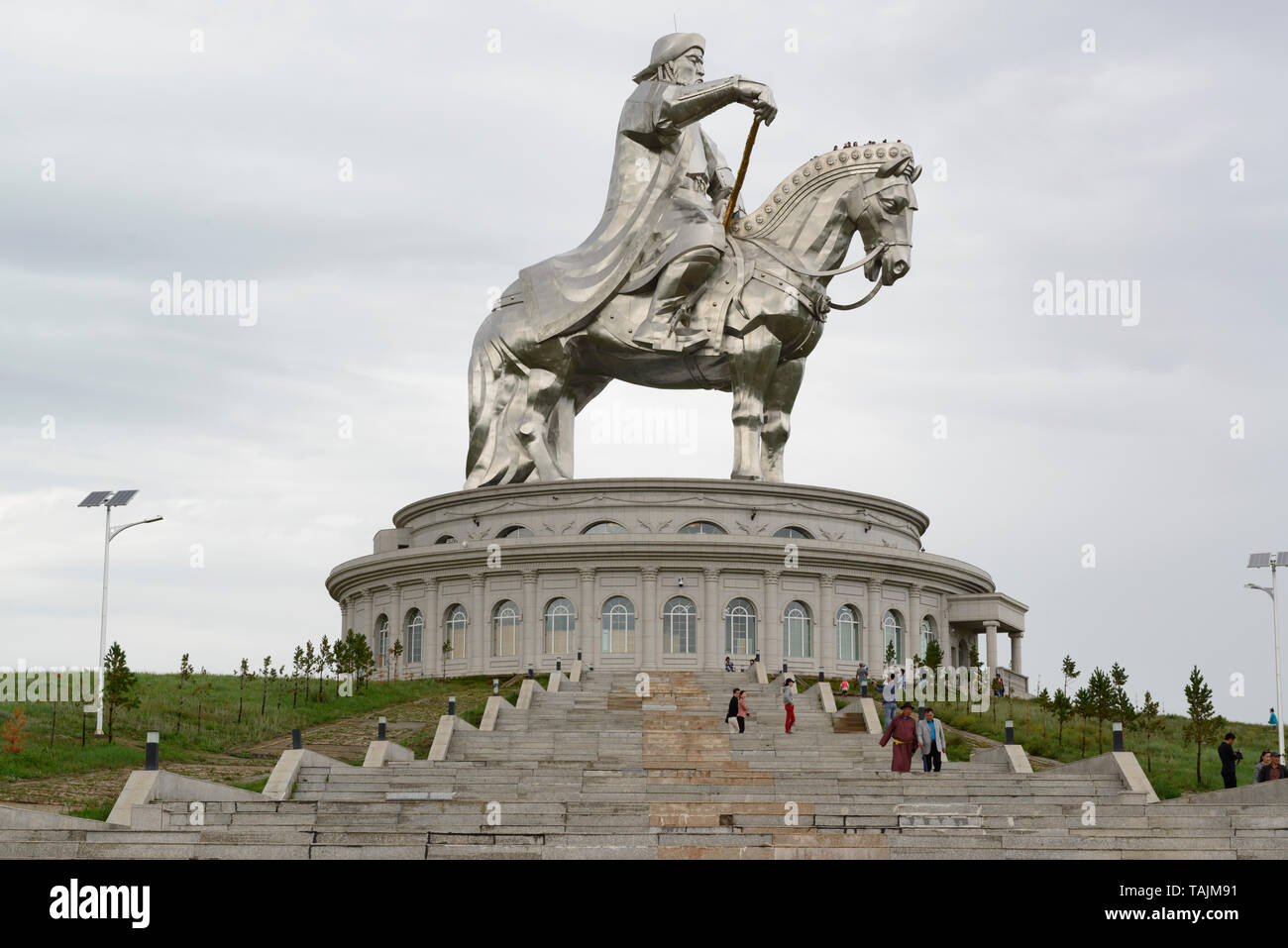 The Genghis Khan Equestrian Statue, part of the Genghis Khan Statue Complex, 54 km east of Ulaanbaatar, Mongolia. Stock Photohttps://www.alamy.com/image-license-details/?v=1https://www.alamy.com/the-genghis-khan-equestrian-statue-part-of-the-genghis-khan-statue-complex-54-km-east-of-ulaanbaatar-mongolia-image247502781.html
The Genghis Khan Equestrian Statue, part of the Genghis Khan Statue Complex, 54 km east of Ulaanbaatar, Mongolia. Stock Photohttps://www.alamy.com/image-license-details/?v=1https://www.alamy.com/the-genghis-khan-equestrian-statue-part-of-the-genghis-khan-statue-complex-54-km-east-of-ulaanbaatar-mongolia-image247502781.htmlRMTAJM91–The Genghis Khan Equestrian Statue, part of the Genghis Khan Statue Complex, 54 km east of Ulaanbaatar, Mongolia.
 Mongol Year : 2007 Germany / Russia / Mongolia Tadanobu Asano Director: Sergei Bodrov Stock Photohttps://www.alamy.com/image-license-details/?v=1https://www.alamy.com/stock-photo-mongol-year-2007-germany-russia-mongolia-tadanobu-asano-director-sergei-22201797.html
Mongol Year : 2007 Germany / Russia / Mongolia Tadanobu Asano Director: Sergei Bodrov Stock Photohttps://www.alamy.com/image-license-details/?v=1https://www.alamy.com/stock-photo-mongol-year-2007-germany-russia-mongolia-tadanobu-asano-director-sergei-22201797.htmlRMB83AH9–Mongol Year : 2007 Germany / Russia / Mongolia Tadanobu Asano Director: Sergei Bodrov
 Dream-vision of Genghis Khan (From: Jean Hayton, Fleur des histoires de la terre d'Orient), c.1410. Artist: Master of Berry Apocalypse (active 1400-1 Stock Photohttps://www.alamy.com/image-license-details/?v=1https://www.alamy.com/dream-vision-of-genghis-khan-from-jean-hayton-fleur-des-histoires-image60385750.html
Dream-vision of Genghis Khan (From: Jean Hayton, Fleur des histoires de la terre d'Orient), c.1410. Artist: Master of Berry Apocalypse (active 1400-1 Stock Photohttps://www.alamy.com/image-license-details/?v=1https://www.alamy.com/dream-vision-of-genghis-khan-from-jean-hayton-fleur-des-histoires-image60385750.htmlRMDE6PHX–Dream-vision of Genghis Khan (From: Jean Hayton, Fleur des histoires de la terre d'Orient), c.1410. Artist: Master of Berry Apocalypse (active 1400-1
 Mongolia, 13th Century Century. at Khan (Ca. 1205-125), The Grandson Of Genghis Khan, Founder Of The Khanate Of Horde D Gold, Stock Photohttps://www.alamy.com/image-license-details/?v=1https://www.alamy.com/stock-photo-mongolia-13th-century-century-at-khan-ca-1205-125-the-grandson-of-41881219.html
Mongolia, 13th Century Century. at Khan (Ca. 1205-125), The Grandson Of Genghis Khan, Founder Of The Khanate Of Horde D Gold, Stock Photohttps://www.alamy.com/image-license-details/?v=1https://www.alamy.com/stock-photo-mongolia-13th-century-century-at-khan-ca-1205-125-the-grandson-of-41881219.htmlRMCC3RWR–Mongolia, 13th Century Century. at Khan (Ca. 1205-125), The Grandson Of Genghis Khan, Founder Of The Khanate Of Horde D Gold,
 1200s PORTRAIT OF GENGHIS KHAN 1167-1227 MONGOL CONQUEROR WARRIOR LEADER Stock Photohttps://www.alamy.com/image-license-details/?v=1https://www.alamy.com/stock-photo-1200s-portrait-of-genghis-khan-1167-1227-mongol-conqueror-warrior-58974294.html
1200s PORTRAIT OF GENGHIS KHAN 1167-1227 MONGOL CONQUEROR WARRIOR LEADER Stock Photohttps://www.alamy.com/image-license-details/?v=1https://www.alamy.com/stock-photo-1200s-portrait-of-genghis-khan-1167-1227-mongol-conqueror-warrior-58974294.htmlRMDBXE8P–1200s PORTRAIT OF GENGHIS KHAN 1167-1227 MONGOL CONQUEROR WARRIOR LEADER
 Genghis Khan portrait from Mongolian money Stock Photohttps://www.alamy.com/image-license-details/?v=1https://www.alamy.com/genghis-khan-portrait-from-mongolian-money-image230973018.html
Genghis Khan portrait from Mongolian money Stock Photohttps://www.alamy.com/image-license-details/?v=1https://www.alamy.com/genghis-khan-portrait-from-mongolian-money-image230973018.htmlRFRBNMCA–Genghis Khan portrait from Mongolian money
 Genghis Khan (1162-1227). Emperor of Mogol Empire. Engraving. Colored. Stock Photohttps://www.alamy.com/image-license-details/?v=1https://www.alamy.com/genghis-khan-1162-1227-emperor-of-mogol-empire-engraving-colored-image210453175.html
Genghis Khan (1162-1227). Emperor of Mogol Empire. Engraving. Colored. Stock Photohttps://www.alamy.com/image-license-details/?v=1https://www.alamy.com/genghis-khan-1162-1227-emperor-of-mogol-empire-engraving-colored-image210453175.htmlRMP6AY4R–Genghis Khan (1162-1227). Emperor of Mogol Empire. Engraving. Colored.
 Statue of Genghis Khan in Atyrau, Kazakhstan Stock Photohttps://www.alamy.com/image-license-details/?v=1https://www.alamy.com/stock-photo-statue-of-genghis-khan-in-atyrau-kazakhstan-20723102.html
Statue of Genghis Khan in Atyrau, Kazakhstan Stock Photohttps://www.alamy.com/image-license-details/?v=1https://www.alamy.com/stock-photo-statue-of-genghis-khan-in-atyrau-kazakhstan-20723102.htmlRMB5M0EP–Statue of Genghis Khan in Atyrau, Kazakhstan
 London, Marble Arch Statue of Genghis Khan by Dashi Namdakov April 2012 Stock Photohttps://www.alamy.com/image-license-details/?v=1https://www.alamy.com/stock-photo-london-marble-arch-statue-of-genghis-khan-by-dashi-namdakov-april-47956373.html
London, Marble Arch Statue of Genghis Khan by Dashi Namdakov April 2012 Stock Photohttps://www.alamy.com/image-license-details/?v=1https://www.alamy.com/stock-photo-london-marble-arch-statue-of-genghis-khan-by-dashi-namdakov-april-47956373.htmlRMCP0GRH–London, Marble Arch Statue of Genghis Khan by Dashi Namdakov April 2012
 Original Film Title: GENGHIS KHAN. English Title: GENGHIS KHAN. Film Director: HENRY LEVIN. Year: 1965. Stars: OMAR SHARIF. Credit: COLUMBIA PICTURES / Album Stock Photohttps://www.alamy.com/image-license-details/?v=1https://www.alamy.com/original-film-title-genghis-khan-english-title-genghis-khan-film-director-henry-levin-year-1965-stars-omar-sharif-credit-columbia-pictures-album-image207042350.html
Original Film Title: GENGHIS KHAN. English Title: GENGHIS KHAN. Film Director: HENRY LEVIN. Year: 1965. Stars: OMAR SHARIF. Credit: COLUMBIA PICTURES / Album Stock Photohttps://www.alamy.com/image-license-details/?v=1https://www.alamy.com/original-film-title-genghis-khan-english-title-genghis-khan-film-director-henry-levin-year-1965-stars-omar-sharif-credit-columbia-pictures-album-image207042350.htmlRMP0RGHJ–Original Film Title: GENGHIS KHAN. English Title: GENGHIS KHAN. Film Director: HENRY LEVIN. Year: 1965. Stars: OMAR SHARIF. Credit: COLUMBIA PICTURES / Album
 Chinggis Khan statue at Sukhbaatar Square; Ulaanbaatar, Ulaanbaatar, Mongolia Stock Photohttps://www.alamy.com/image-license-details/?v=1https://www.alamy.com/chinggis-khan-statue-at-sukhbaatar-square-ulaanbaatar-ulaanbaatar-mongolia-image180476665.html
Chinggis Khan statue at Sukhbaatar Square; Ulaanbaatar, Ulaanbaatar, Mongolia Stock Photohttps://www.alamy.com/image-license-details/?v=1https://www.alamy.com/chinggis-khan-statue-at-sukhbaatar-square-ulaanbaatar-ulaanbaatar-mongolia-image180476665.htmlRFMDHBR5–Chinggis Khan statue at Sukhbaatar Square; Ulaanbaatar, Ulaanbaatar, Mongolia
 Dschinghis Khan Genghis Khan Francoise Dorleac, Omar Sharif Dschinghis Khan (Omar Sharif) hat sich in die schoene Prinzessin Stock Photohttps://www.alamy.com/image-license-details/?v=1https://www.alamy.com/stock-photo-dschinghis-khan-genghis-khan-francoise-dorleac-omar-sharif-dschinghis-52698239.html
Dschinghis Khan Genghis Khan Francoise Dorleac, Omar Sharif Dschinghis Khan (Omar Sharif) hat sich in die schoene Prinzessin Stock Photohttps://www.alamy.com/image-license-details/?v=1https://www.alamy.com/stock-photo-dschinghis-khan-genghis-khan-francoise-dorleac-omar-sharif-dschinghis-52698239.htmlRMD1MH3Y–Dschinghis Khan Genghis Khan Francoise Dorleac, Omar Sharif Dschinghis Khan (Omar Sharif) hat sich in die schoene Prinzessin
 A Statue Of Genghis Khan The Founder Of The Mongol Empire; Ulaanbatar Mongolia Stock Photohttps://www.alamy.com/image-license-details/?v=1https://www.alamy.com/stock-photo-a-statue-of-genghis-khan-the-founder-of-the-mongol-empire-ulaanbatar-81183001.html
A Statue Of Genghis Khan The Founder Of The Mongol Empire; Ulaanbatar Mongolia Stock Photohttps://www.alamy.com/image-license-details/?v=1https://www.alamy.com/stock-photo-a-statue-of-genghis-khan-the-founder-of-the-mongol-empire-ulaanbatar-81183001.htmlRMEM25MW–A Statue Of Genghis Khan The Founder Of The Mongol Empire; Ulaanbatar Mongolia
 Russia: Sacking of Suzdal by Batu Khan in February, 1238, during the Mongol Invasion of Russia. A miniature from the 16th century chronicle of Suzdal. Batu Khan (c. 1207–1255) was a Mongol ruler and founder of the Ulus of Jochi (or Golden Horde), the sub-khanate of the Mongol Empire. Batu was a son of Jochi and grandson of Genghis Khan. His ulus was the chief state of the Golden Horde (or Kipchak Khanate), which ruled Rus and the Caucasus for around 250 years, after also destroying the armies of Poland and Hungary. Stock Photohttps://www.alamy.com/image-license-details/?v=1https://www.alamy.com/russia-sacking-of-suzdal-by-batu-khan-in-february-1238-during-the-mongol-invasion-of-russia-a-miniature-from-the-16th-century-chronicle-of-suzdal-batu-khan-c-12071255-was-a-mongol-ruler-and-founder-of-the-ulus-of-jochi-or-golden-horde-the-sub-khanate-of-the-mongol-empire-batu-was-a-son-of-jochi-and-grandson-of-genghis-khan-his-ulus-was-the-chief-state-of-the-golden-horde-or-kipchak-khanate-which-ruled-rus-and-the-caucasus-for-around-250-years-after-also-destroying-the-armies-of-poland-and-hungary-image344230878.html
Russia: Sacking of Suzdal by Batu Khan in February, 1238, during the Mongol Invasion of Russia. A miniature from the 16th century chronicle of Suzdal. Batu Khan (c. 1207–1255) was a Mongol ruler and founder of the Ulus of Jochi (or Golden Horde), the sub-khanate of the Mongol Empire. Batu was a son of Jochi and grandson of Genghis Khan. His ulus was the chief state of the Golden Horde (or Kipchak Khanate), which ruled Rus and the Caucasus for around 250 years, after also destroying the armies of Poland and Hungary. Stock Photohttps://www.alamy.com/image-license-details/?v=1https://www.alamy.com/russia-sacking-of-suzdal-by-batu-khan-in-february-1238-during-the-mongol-invasion-of-russia-a-miniature-from-the-16th-century-chronicle-of-suzdal-batu-khan-c-12071255-was-a-mongol-ruler-and-founder-of-the-ulus-of-jochi-or-golden-horde-the-sub-khanate-of-the-mongol-empire-batu-was-a-son-of-jochi-and-grandson-of-genghis-khan-his-ulus-was-the-chief-state-of-the-golden-horde-or-kipchak-khanate-which-ruled-rus-and-the-caucasus-for-around-250-years-after-also-destroying-the-armies-of-poland-and-hungary-image344230878.htmlRM2B011YX–Russia: Sacking of Suzdal by Batu Khan in February, 1238, during the Mongol Invasion of Russia. A miniature from the 16th century chronicle of Suzdal. Batu Khan (c. 1207–1255) was a Mongol ruler and founder of the Ulus of Jochi (or Golden Horde), the sub-khanate of the Mongol Empire. Batu was a son of Jochi and grandson of Genghis Khan. His ulus was the chief state of the Golden Horde (or Kipchak Khanate), which ruled Rus and the Caucasus for around 250 years, after also destroying the armies of Poland and Hungary.
 Art inspired by Tumanba Khan, His Wife, and His Nine Sons', Folio from a Chingiznama (Book of Genghis Khan), ca. 1596, Made in present-day Pakistan, probably Lahore, Ink, opaque watercolor, and gold on paper, Page: 15 x 10 in. (38.1 x 25.4 cm), Codices, Basawan (Indian, active ca. 1556, Classic works modernized by Artotop with a splash of modernity. Shapes, color and value, eye-catching visual impact on art. Emotions through freedom of artworks in a contemporary way. A timeless message pursuing a wildly creative new direction. Artists turning to the digital medium and creating the Artotop NFT Stock Photohttps://www.alamy.com/image-license-details/?v=1https://www.alamy.com/art-inspired-by-tumanba-khan-his-wife-and-his-nine-sons-folio-from-a-chingiznama-book-of-genghis-khan-ca-1596-made-in-present-day-pakistan-probably-lahore-ink-opaque-watercolor-and-gold-on-paper-page-15-x-10-in-381-x-254-cm-codices-basawan-indian-active-ca-1556-classic-works-modernized-by-artotop-with-a-splash-of-modernity-shapes-color-and-value-eye-catching-visual-impact-on-art-emotions-through-freedom-of-artworks-in-a-contemporary-way-a-timeless-message-pursuing-a-wildly-creative-new-direction-artists-turning-to-the-digital-medium-and-creating-the-artotop-nft-image463027801.html
Art inspired by Tumanba Khan, His Wife, and His Nine Sons', Folio from a Chingiznama (Book of Genghis Khan), ca. 1596, Made in present-day Pakistan, probably Lahore, Ink, opaque watercolor, and gold on paper, Page: 15 x 10 in. (38.1 x 25.4 cm), Codices, Basawan (Indian, active ca. 1556, Classic works modernized by Artotop with a splash of modernity. Shapes, color and value, eye-catching visual impact on art. Emotions through freedom of artworks in a contemporary way. A timeless message pursuing a wildly creative new direction. Artists turning to the digital medium and creating the Artotop NFT Stock Photohttps://www.alamy.com/image-license-details/?v=1https://www.alamy.com/art-inspired-by-tumanba-khan-his-wife-and-his-nine-sons-folio-from-a-chingiznama-book-of-genghis-khan-ca-1596-made-in-present-day-pakistan-probably-lahore-ink-opaque-watercolor-and-gold-on-paper-page-15-x-10-in-381-x-254-cm-codices-basawan-indian-active-ca-1556-classic-works-modernized-by-artotop-with-a-splash-of-modernity-shapes-color-and-value-eye-catching-visual-impact-on-art-emotions-through-freedom-of-artworks-in-a-contemporary-way-a-timeless-message-pursuing-a-wildly-creative-new-direction-artists-turning-to-the-digital-medium-and-creating-the-artotop-nft-image463027801.htmlRF2HW8MK5–Art inspired by Tumanba Khan, His Wife, and His Nine Sons', Folio from a Chingiznama (Book of Genghis Khan), ca. 1596, Made in present-day Pakistan, probably Lahore, Ink, opaque watercolor, and gold on paper, Page: 15 x 10 in. (38.1 x 25.4 cm), Codices, Basawan (Indian, active ca. 1556, Classic works modernized by Artotop with a splash of modernity. Shapes, color and value, eye-catching visual impact on art. Emotions through freedom of artworks in a contemporary way. A timeless message pursuing a wildly creative new direction. Artists turning to the digital medium and creating the Artotop NFT